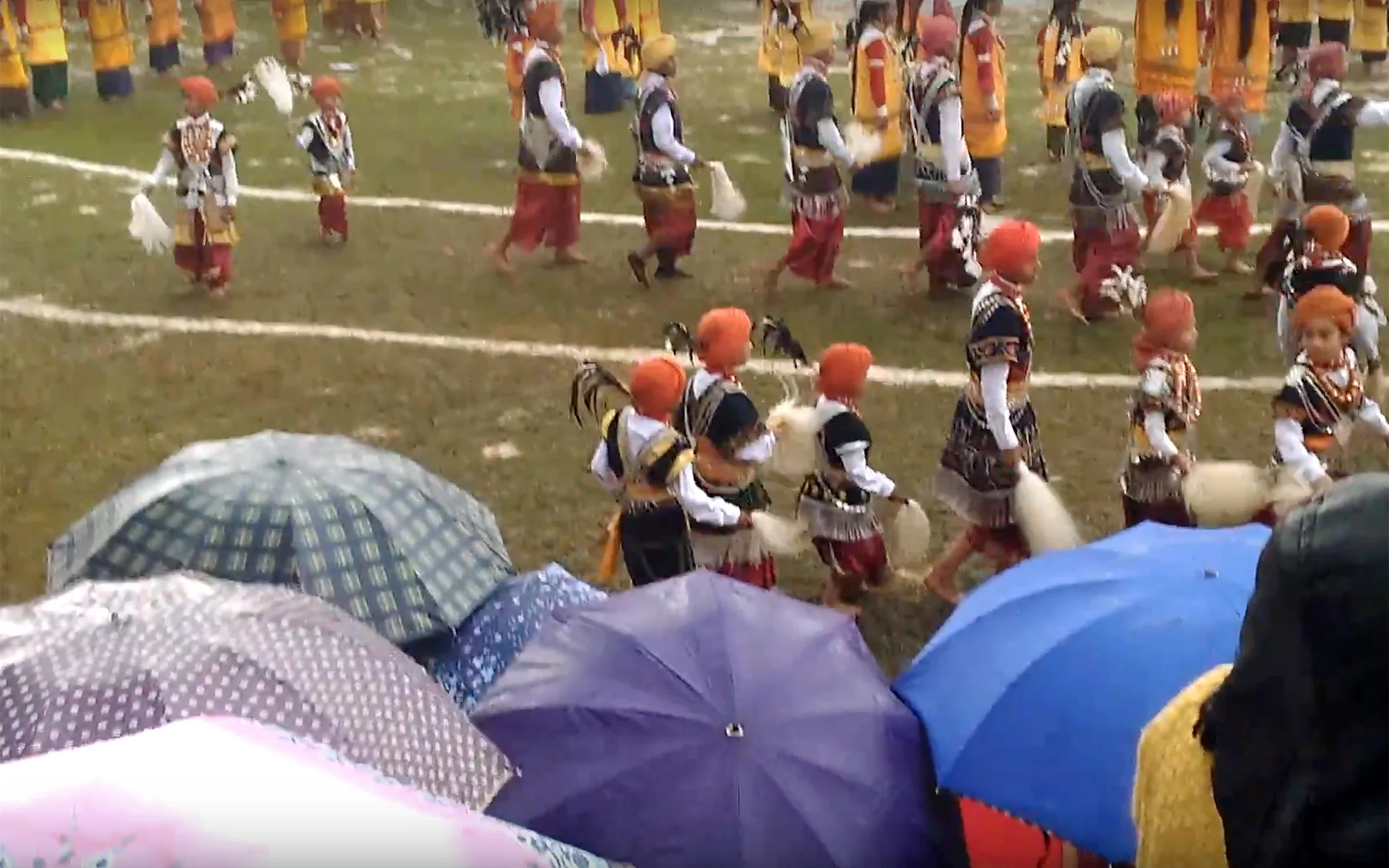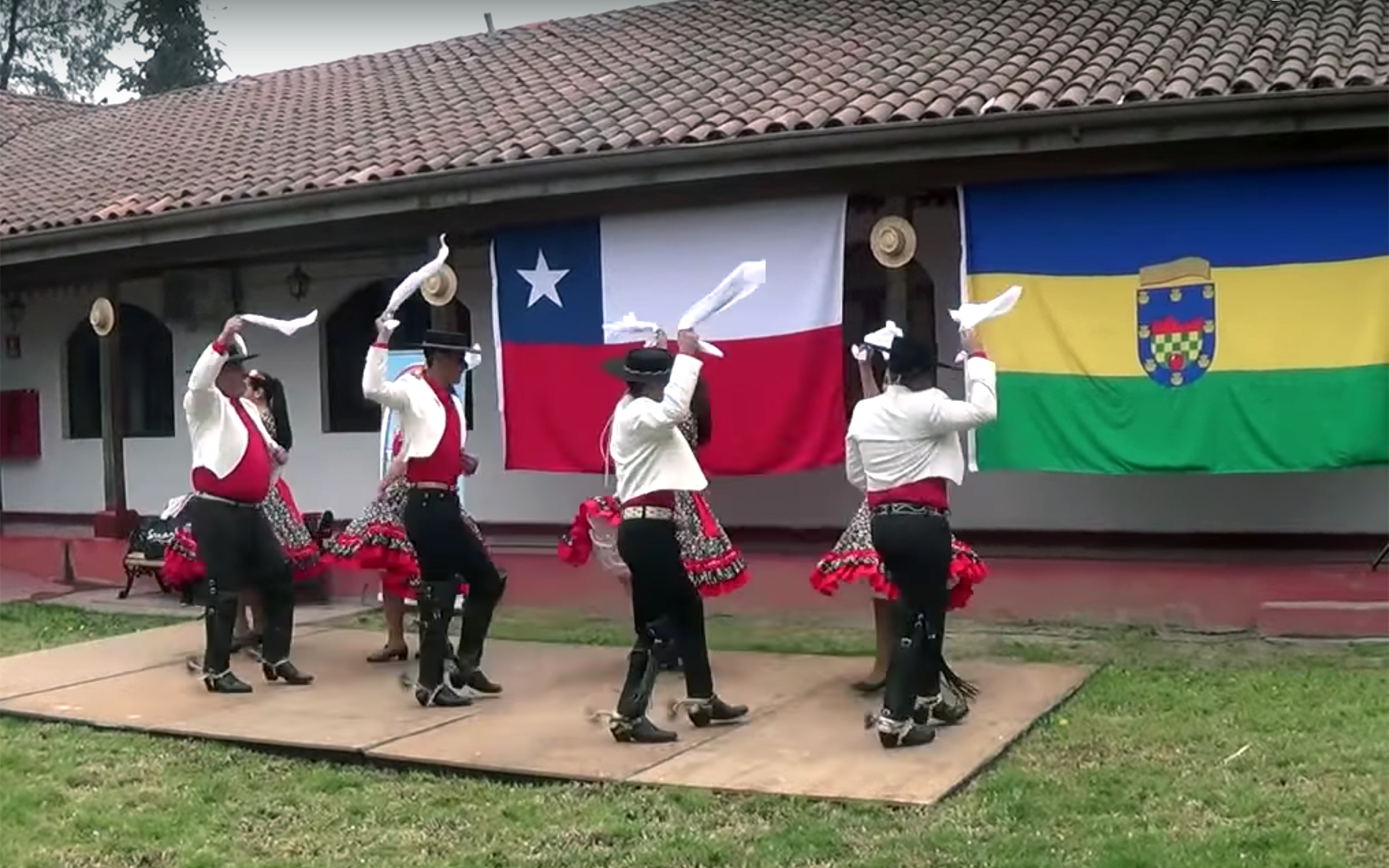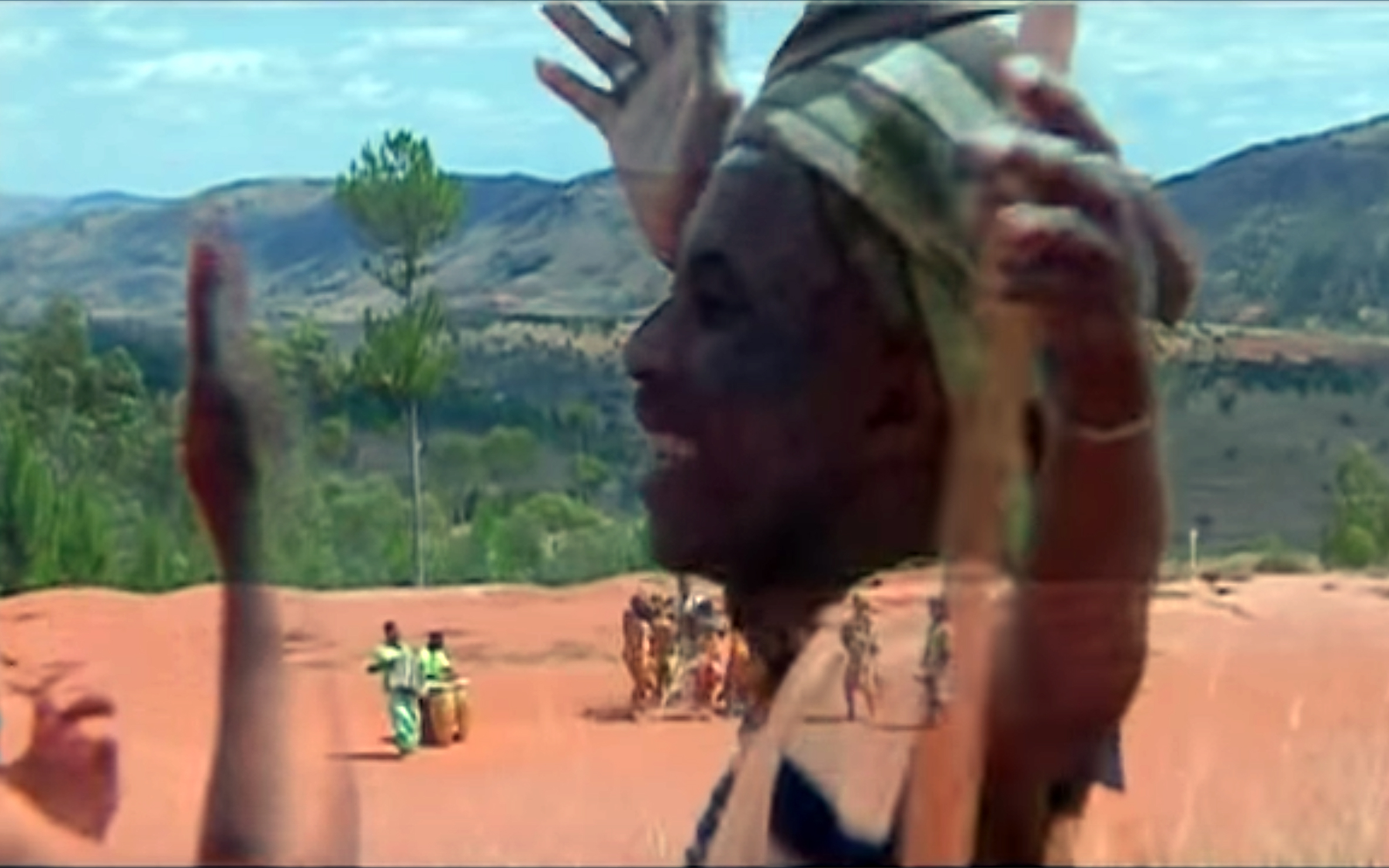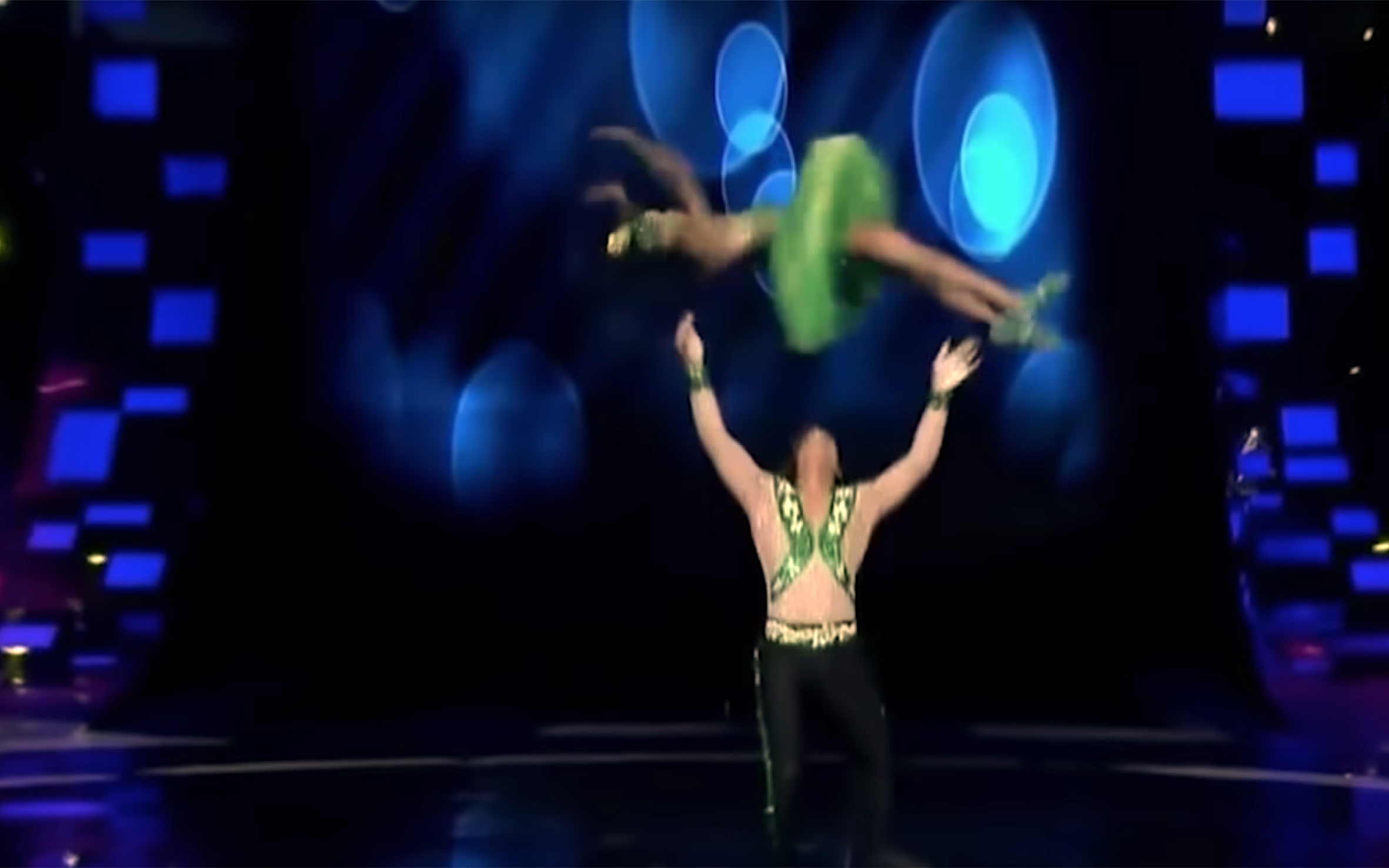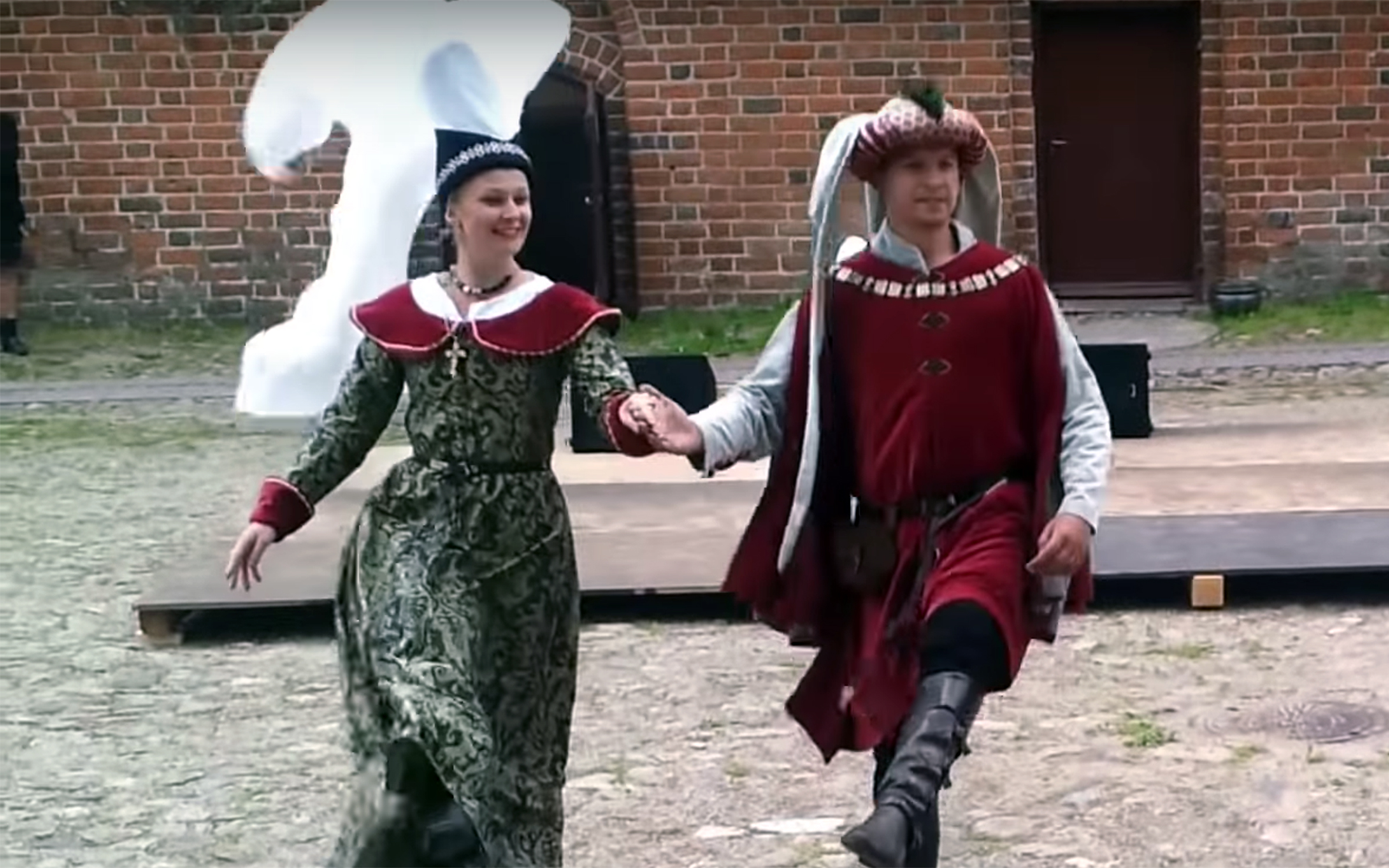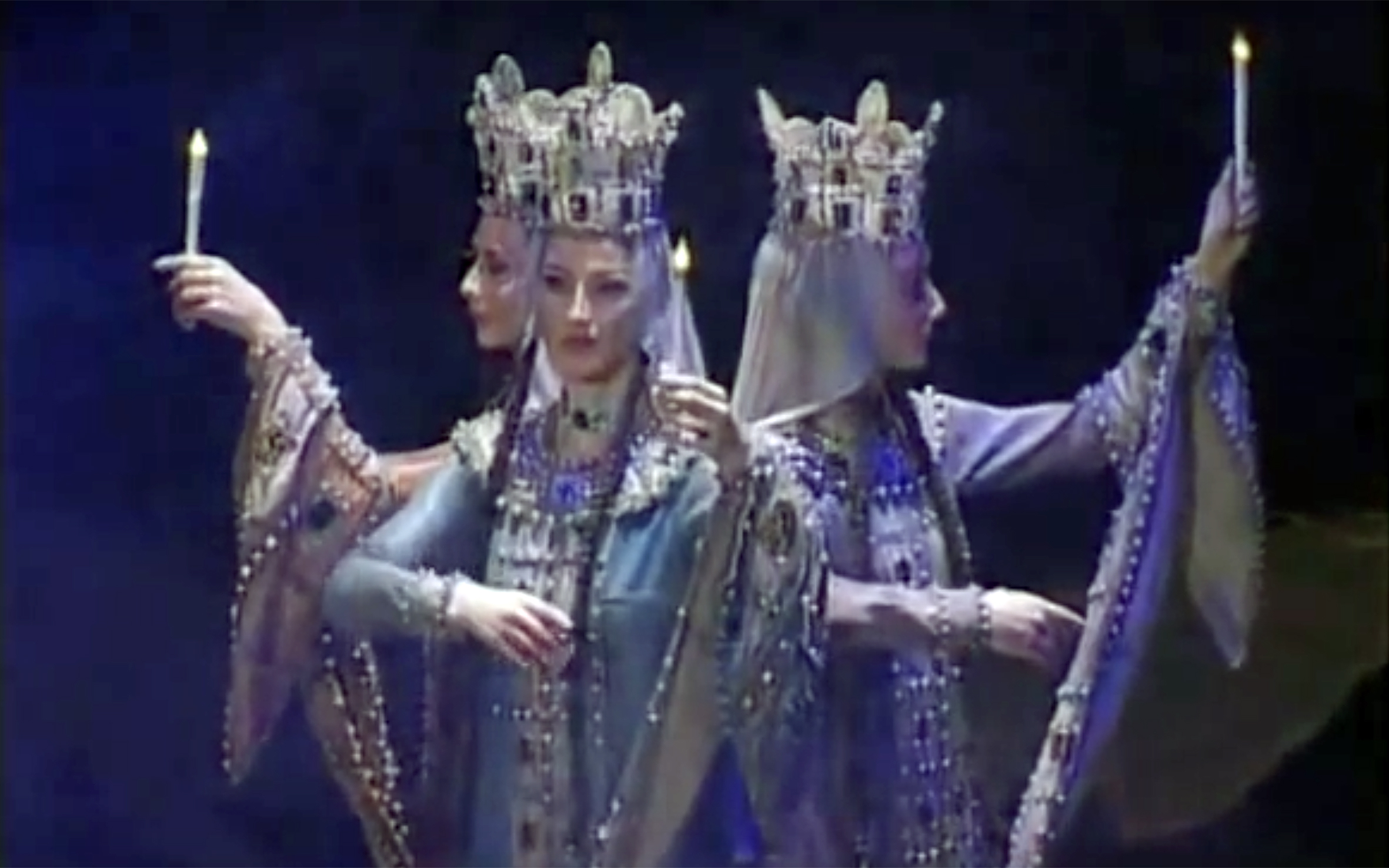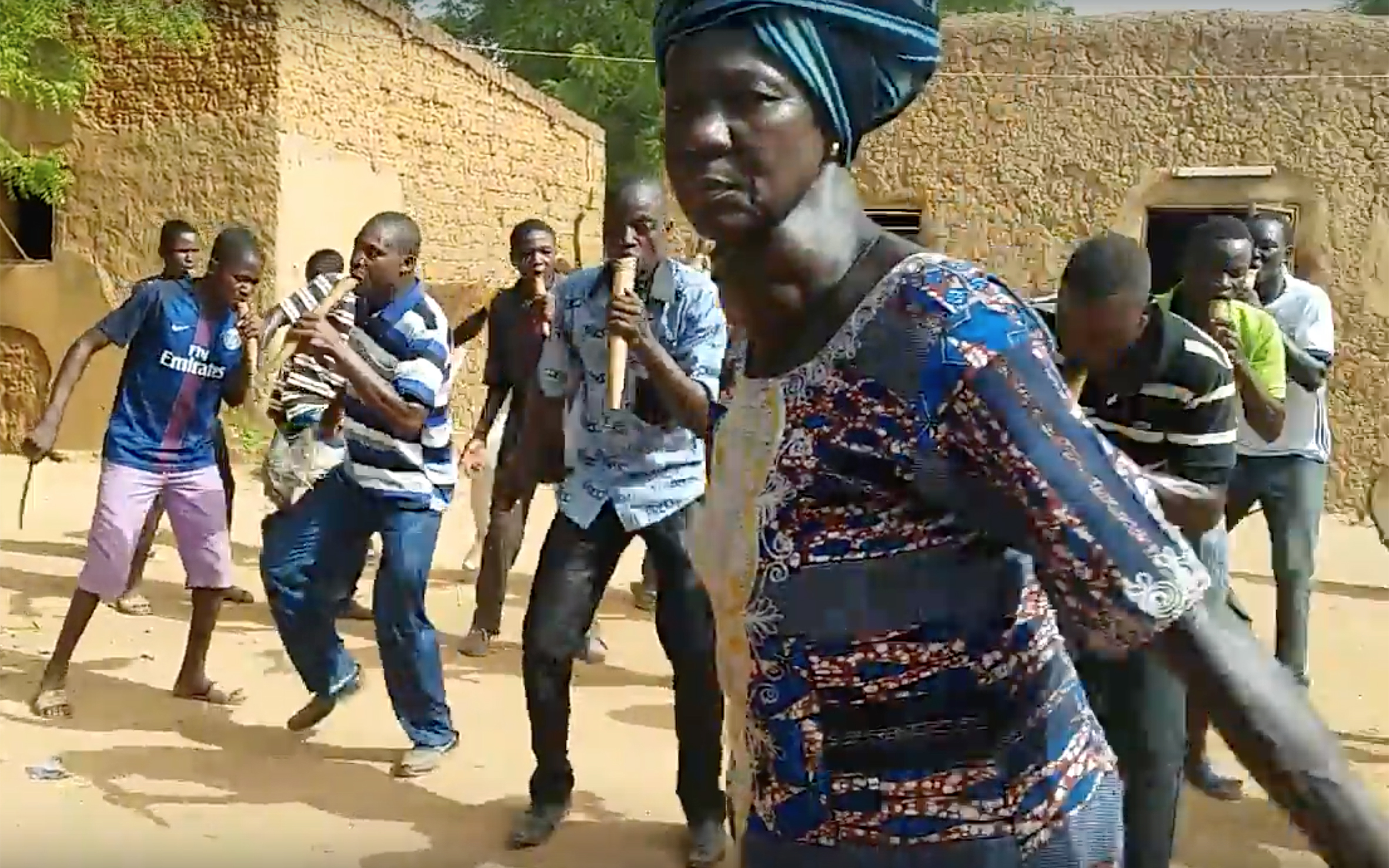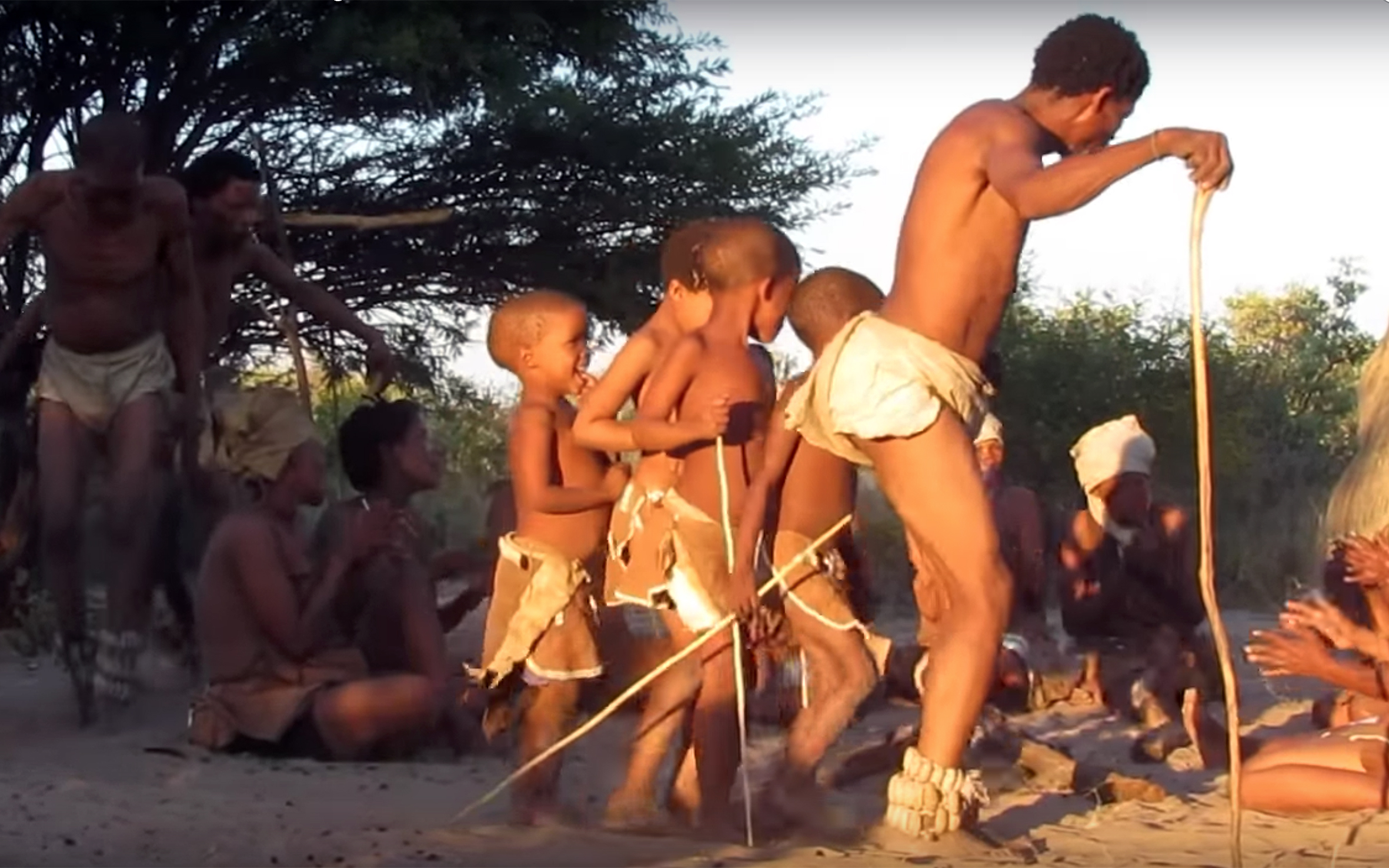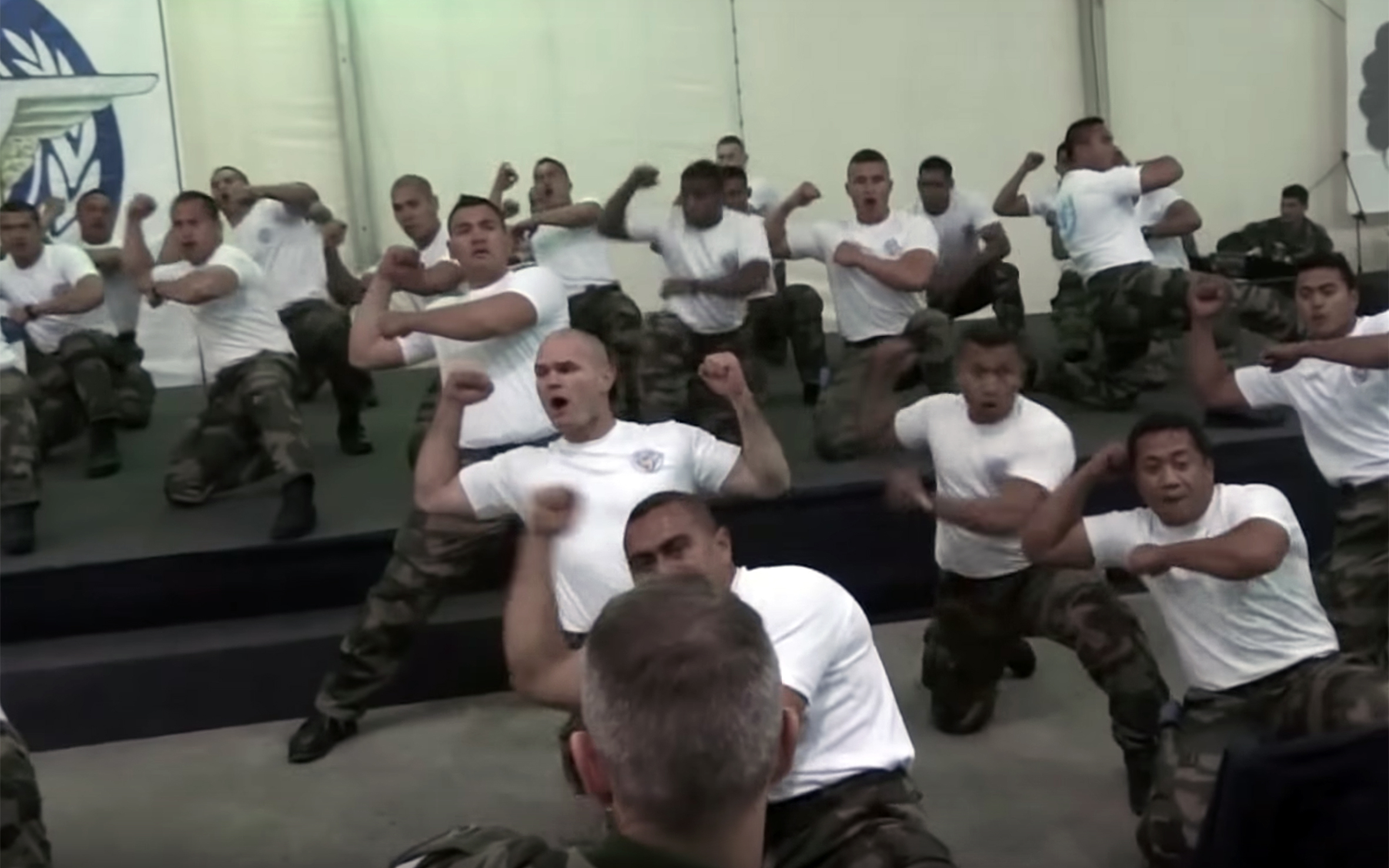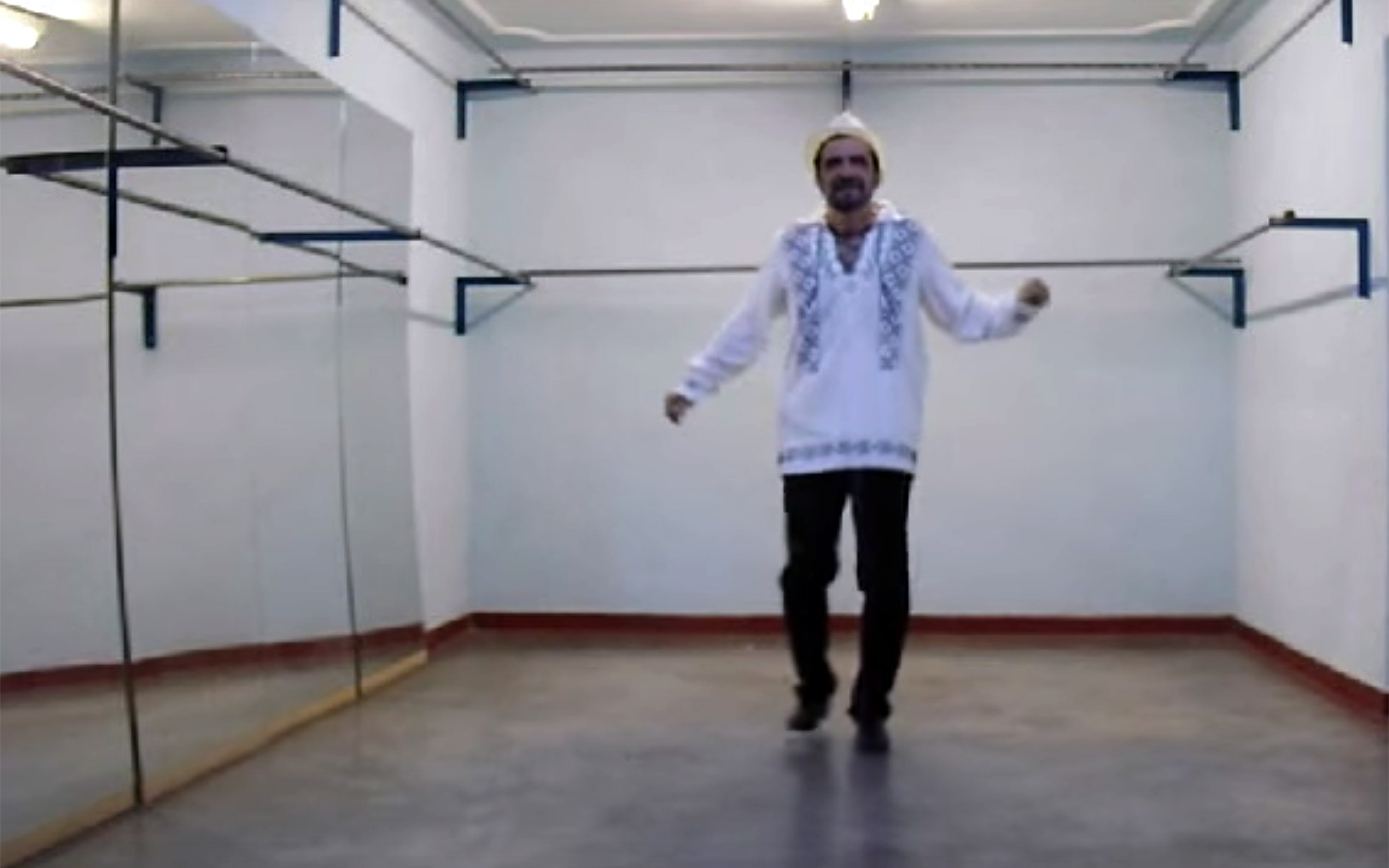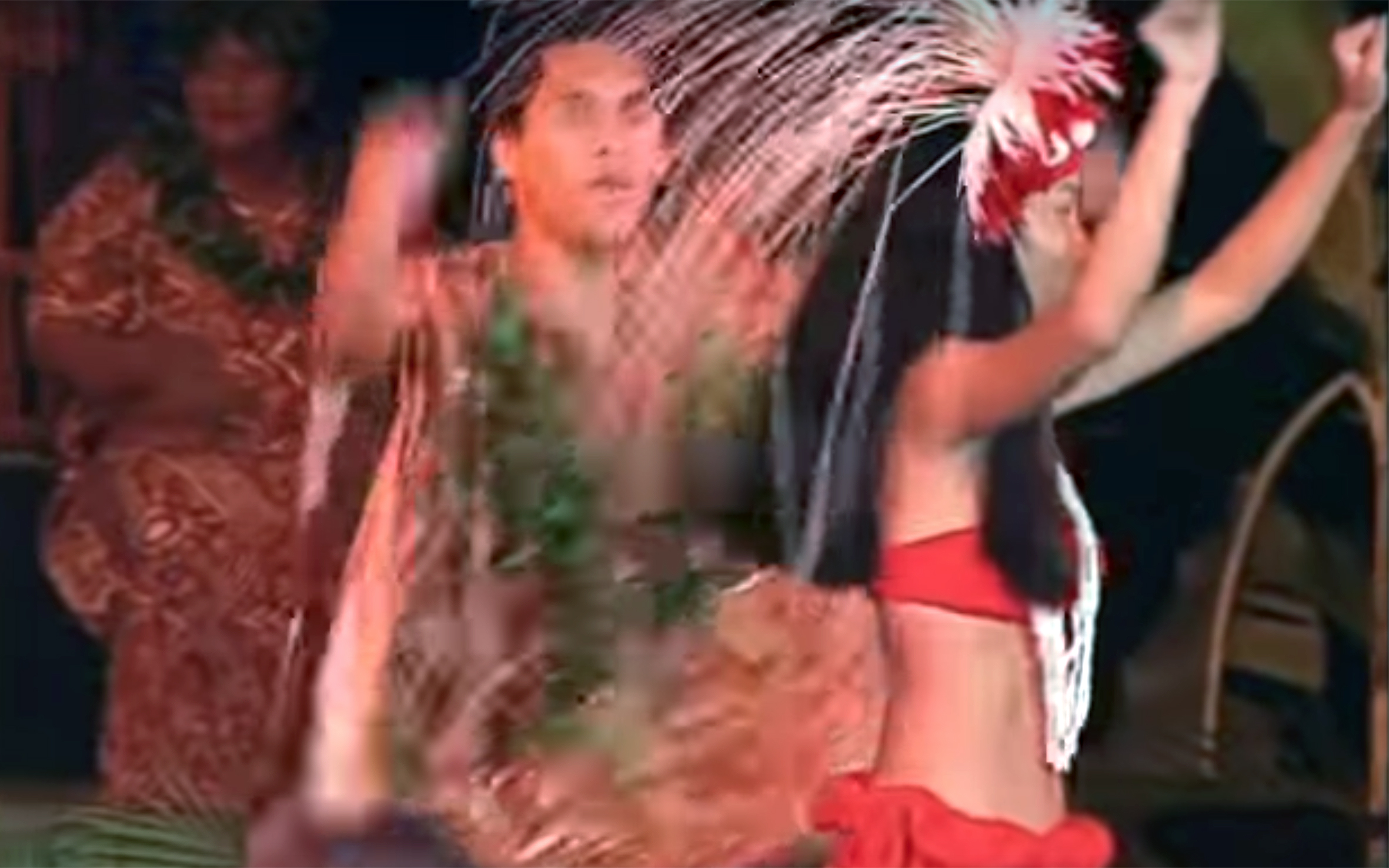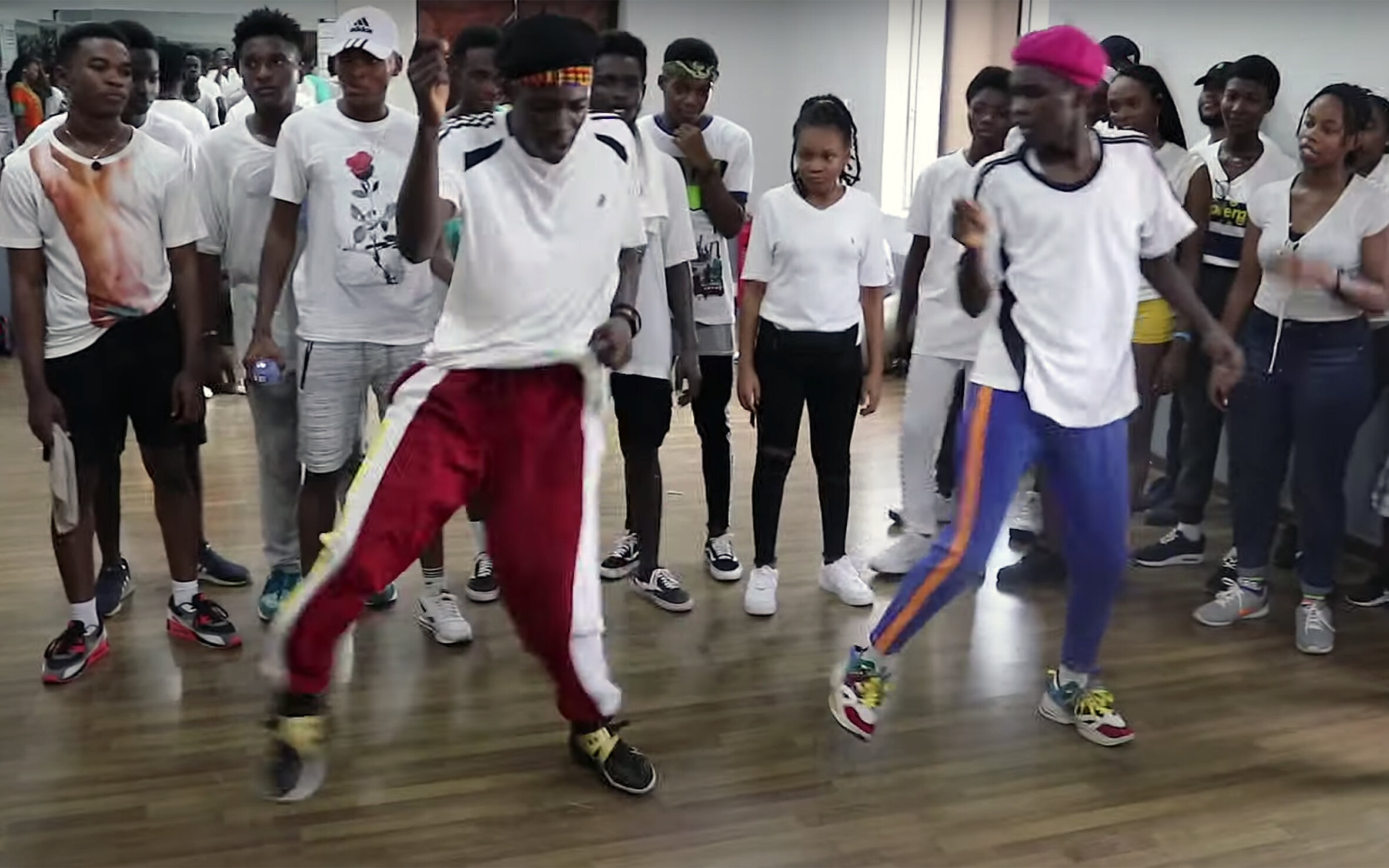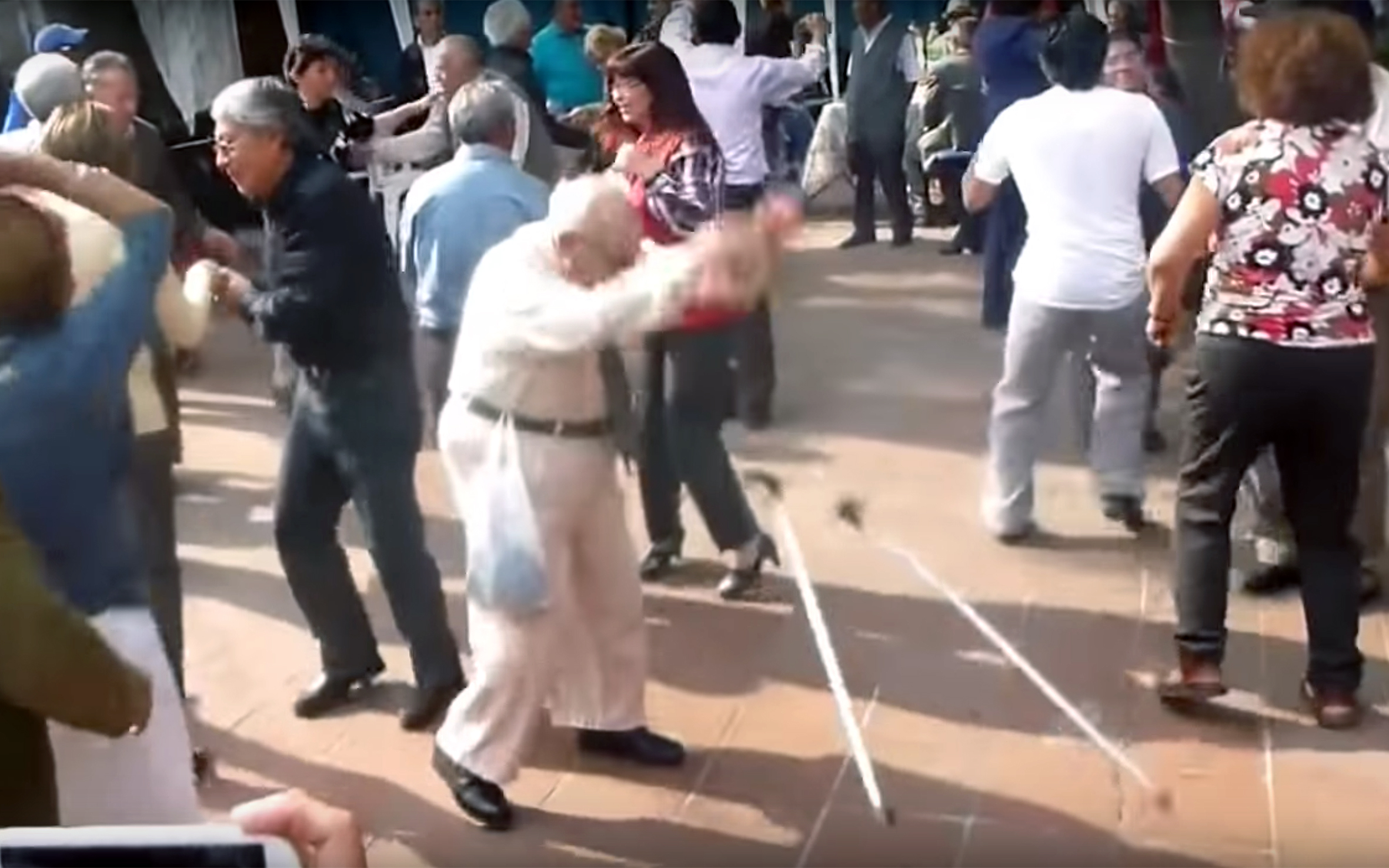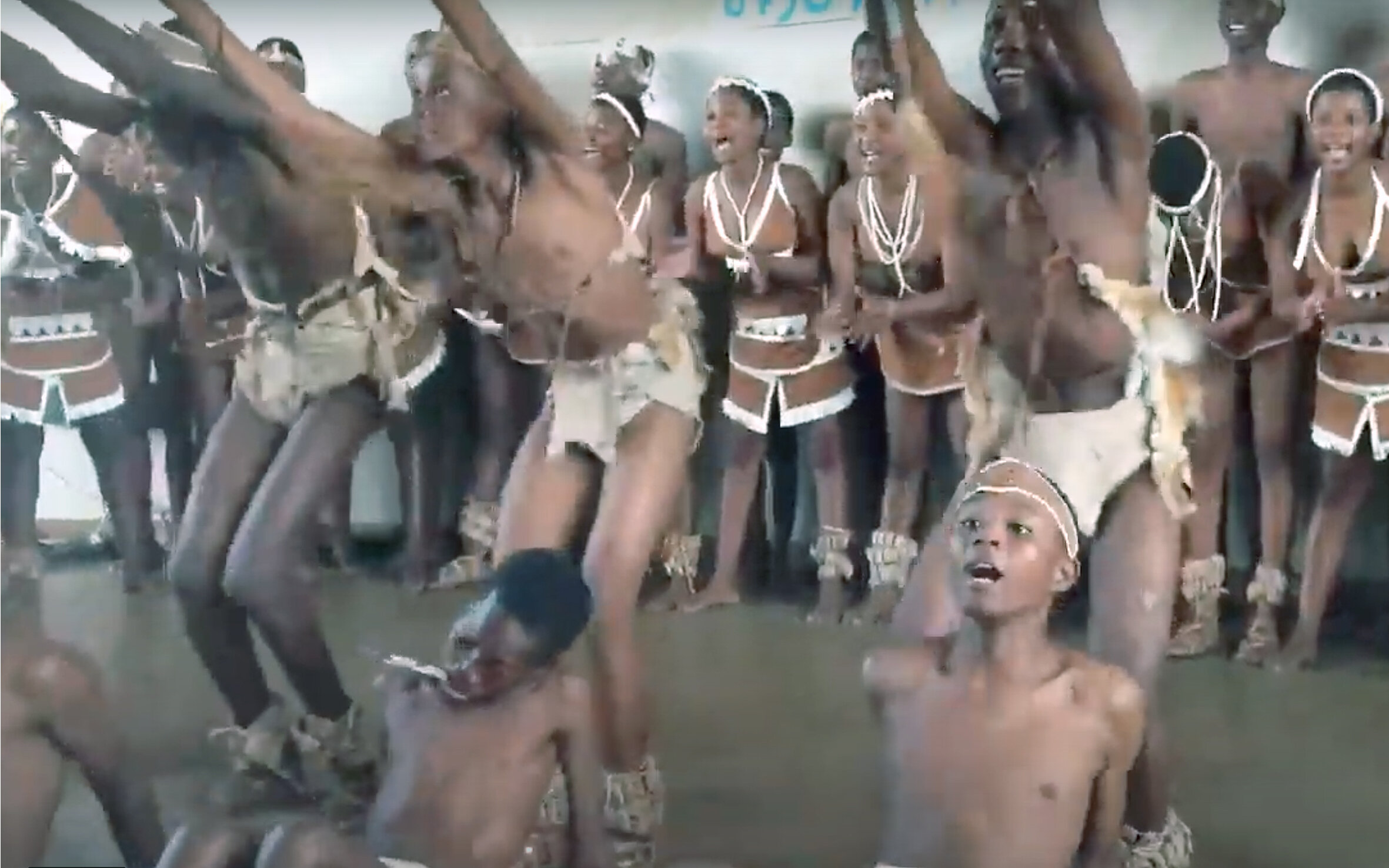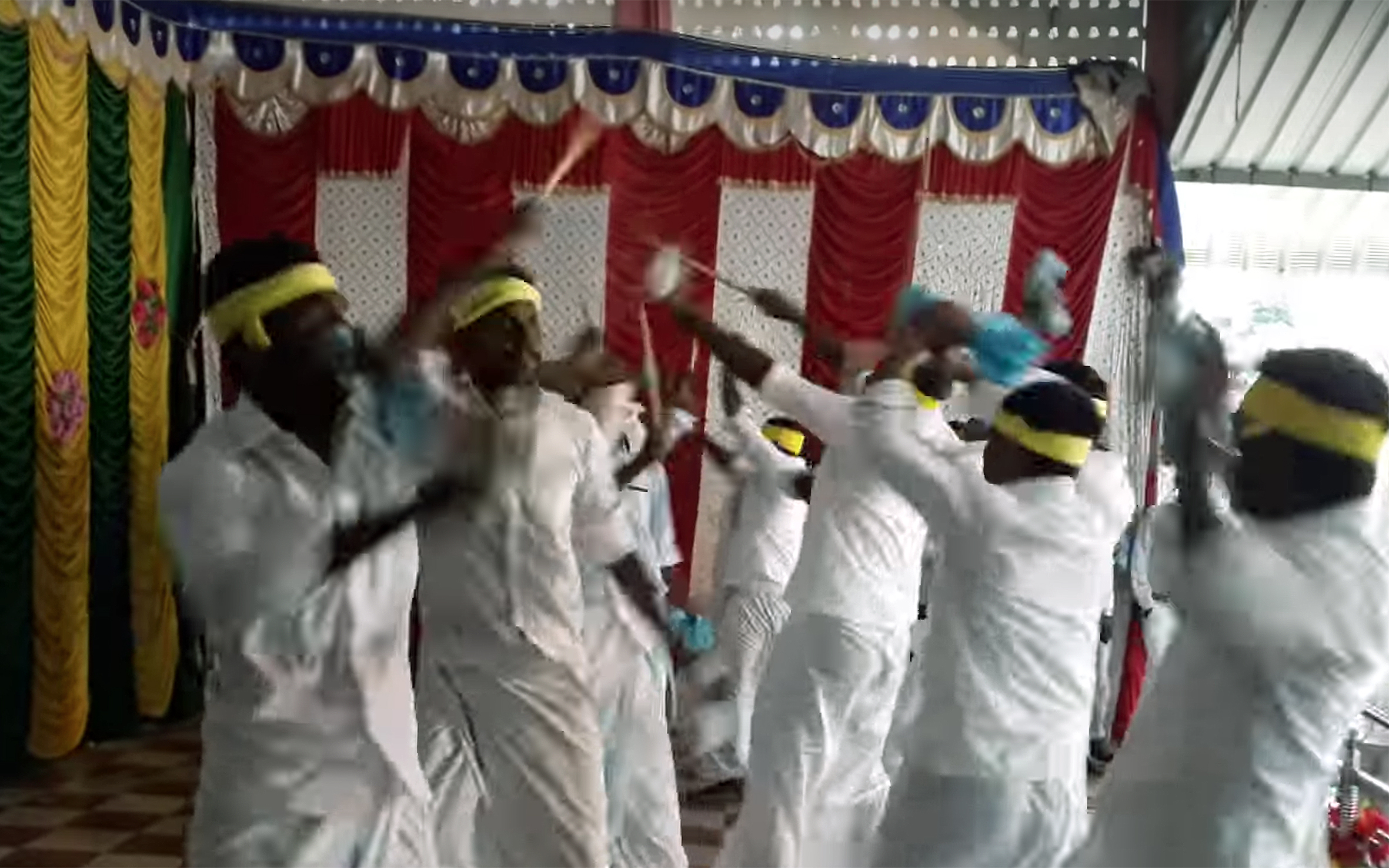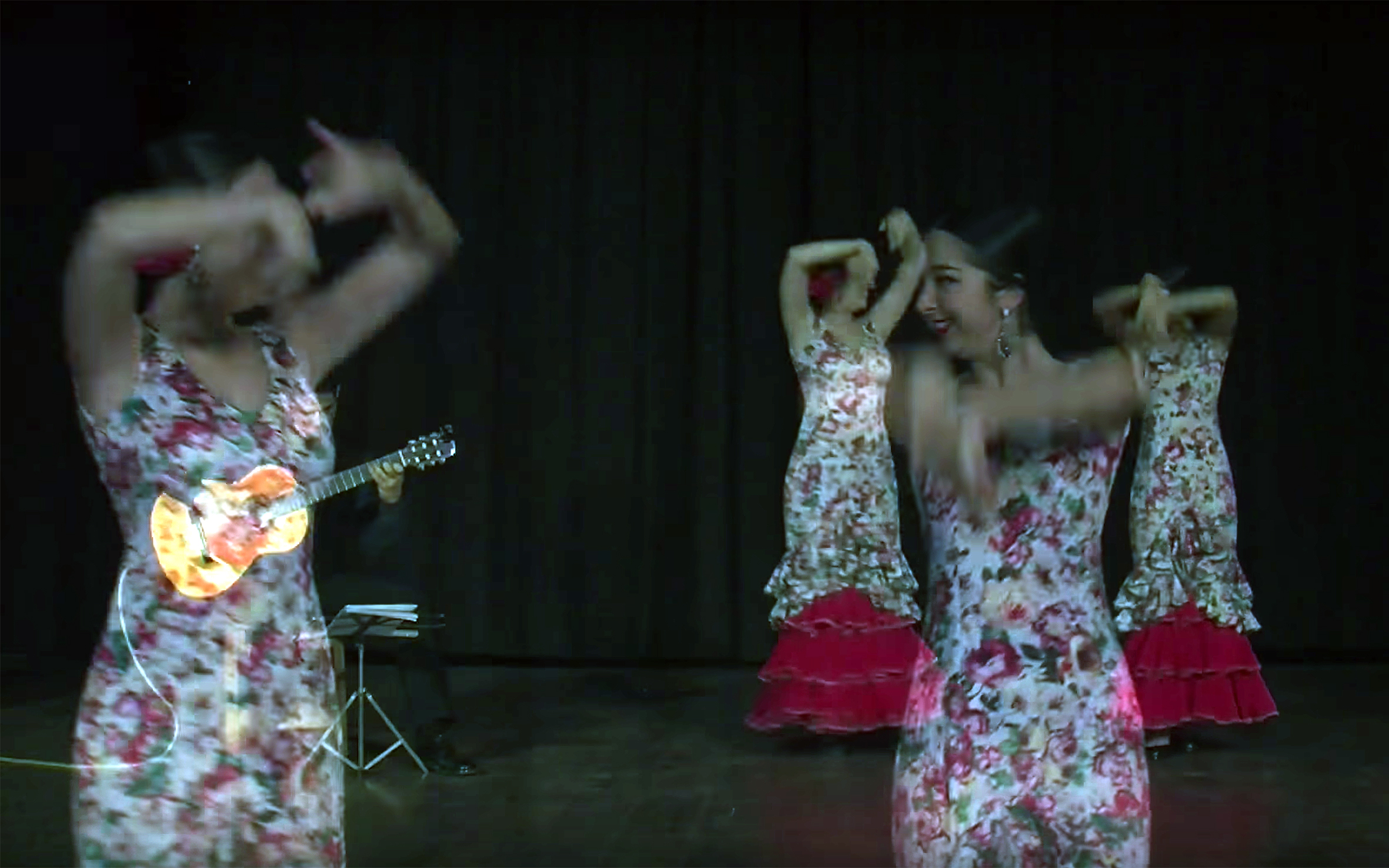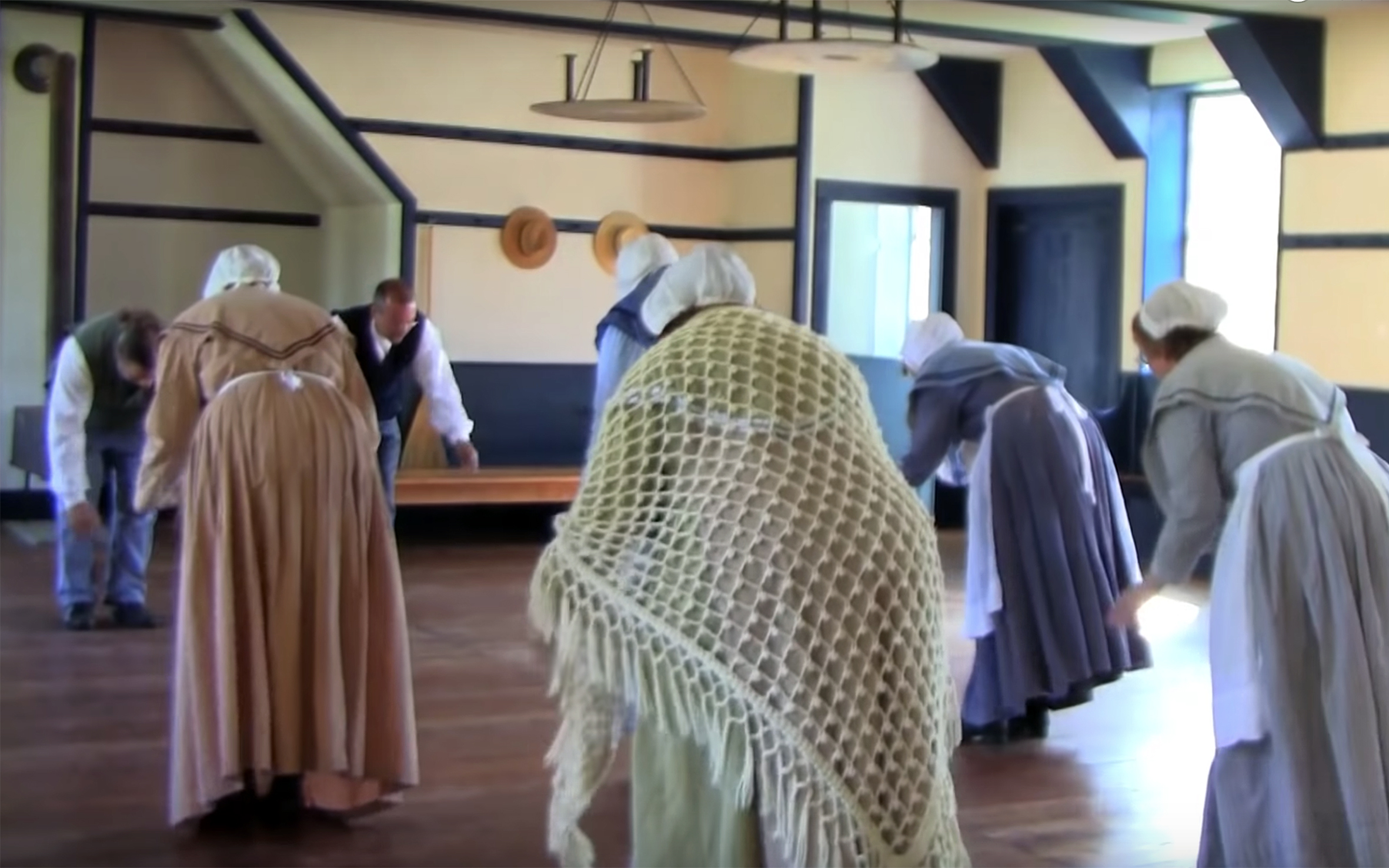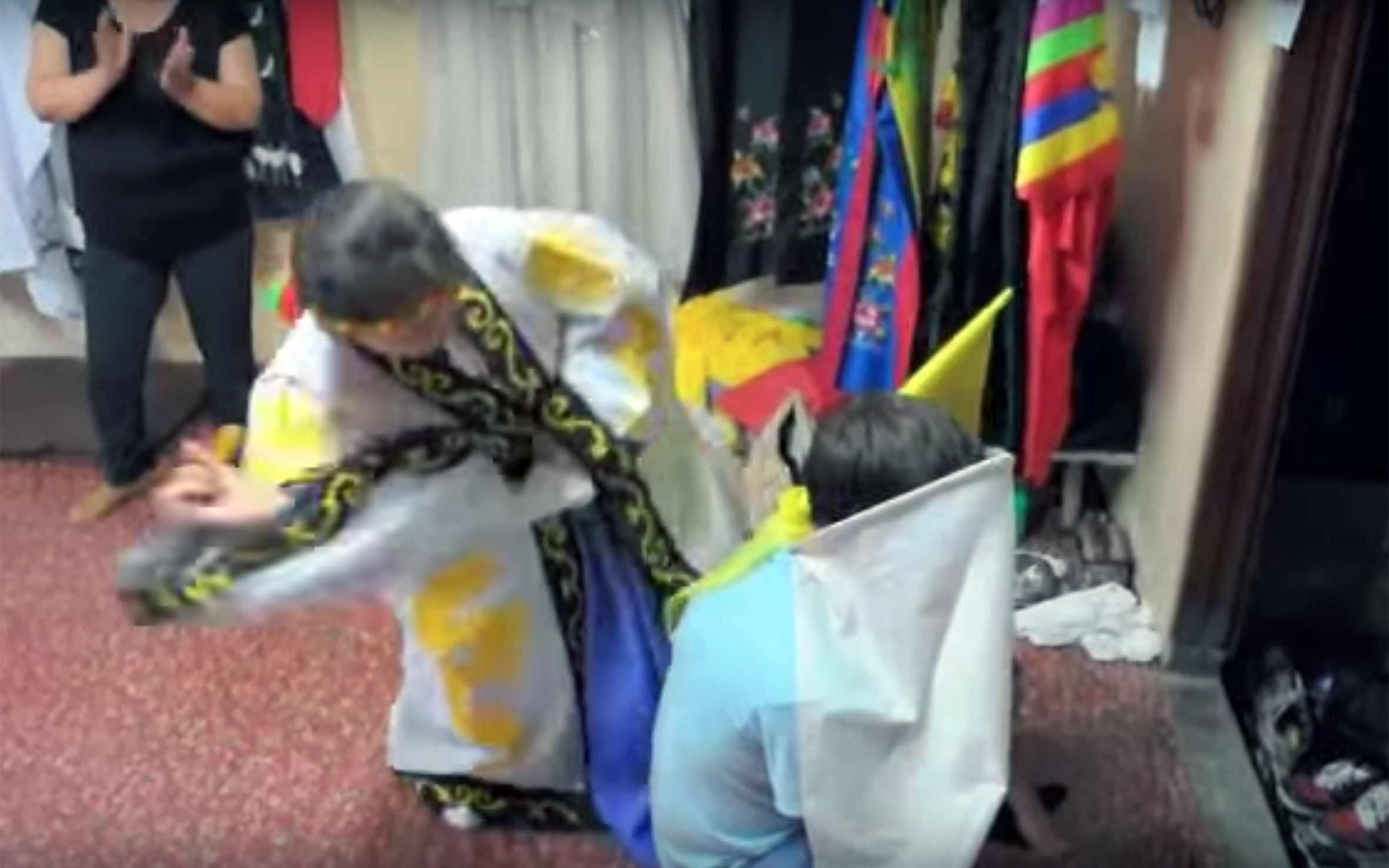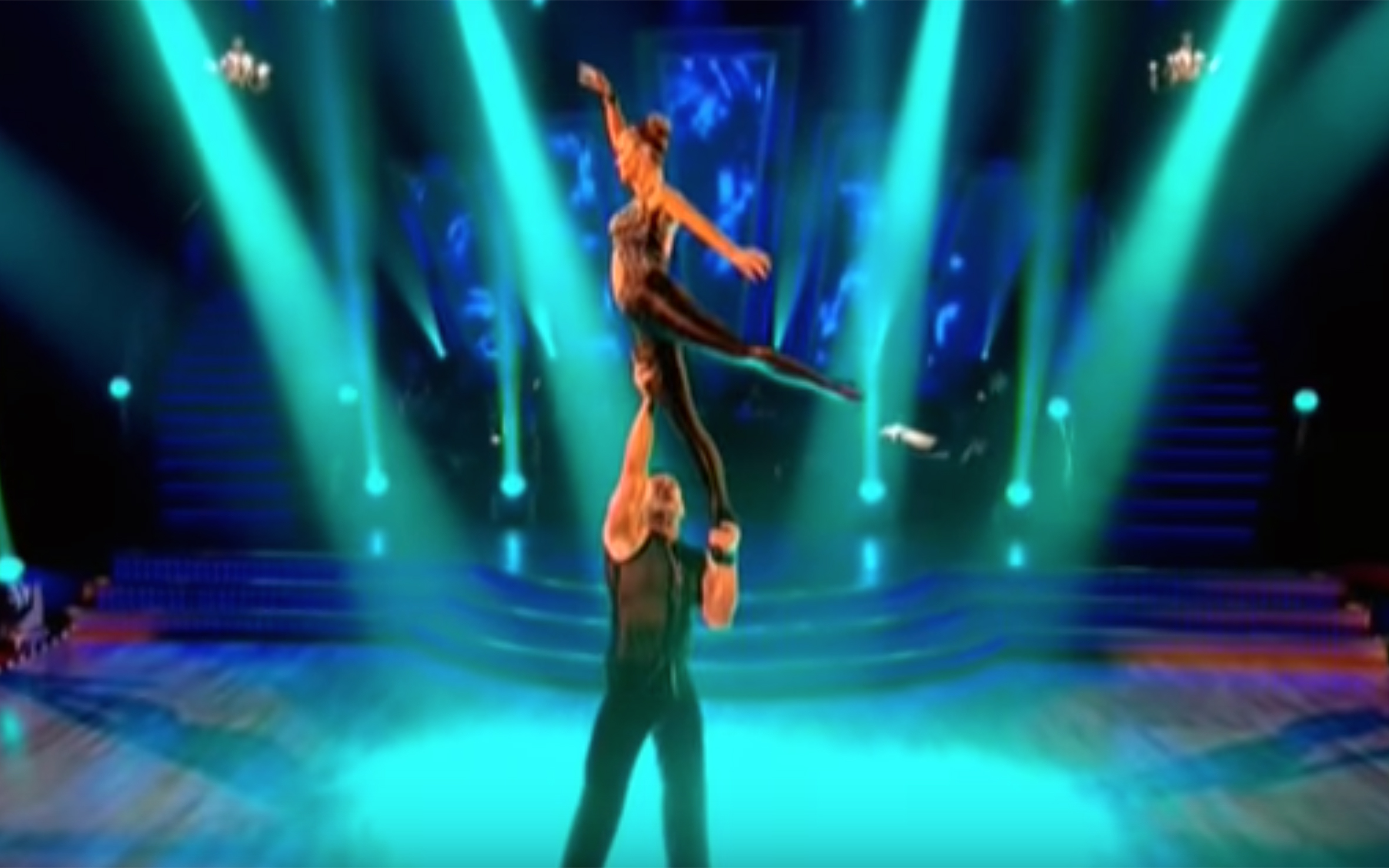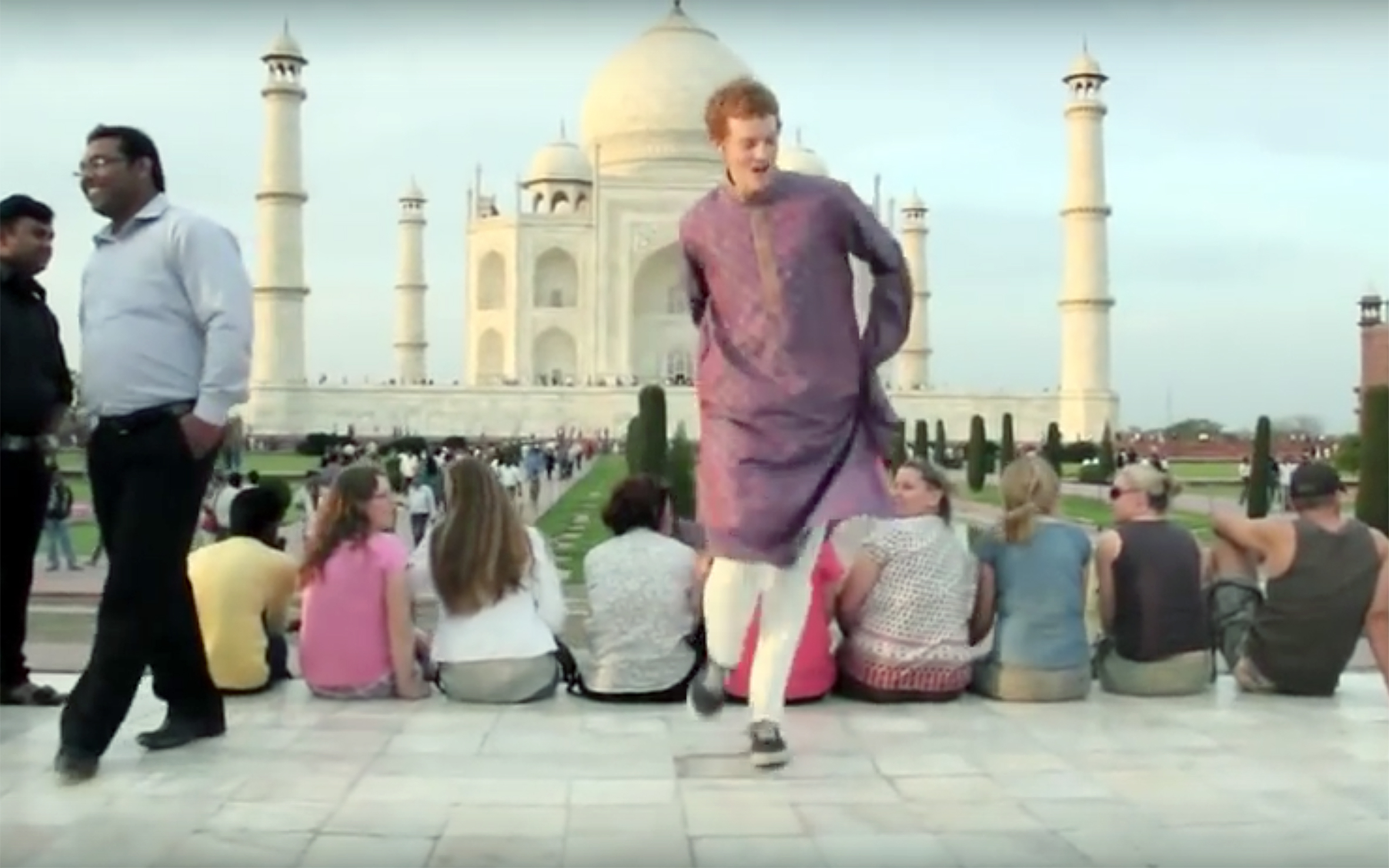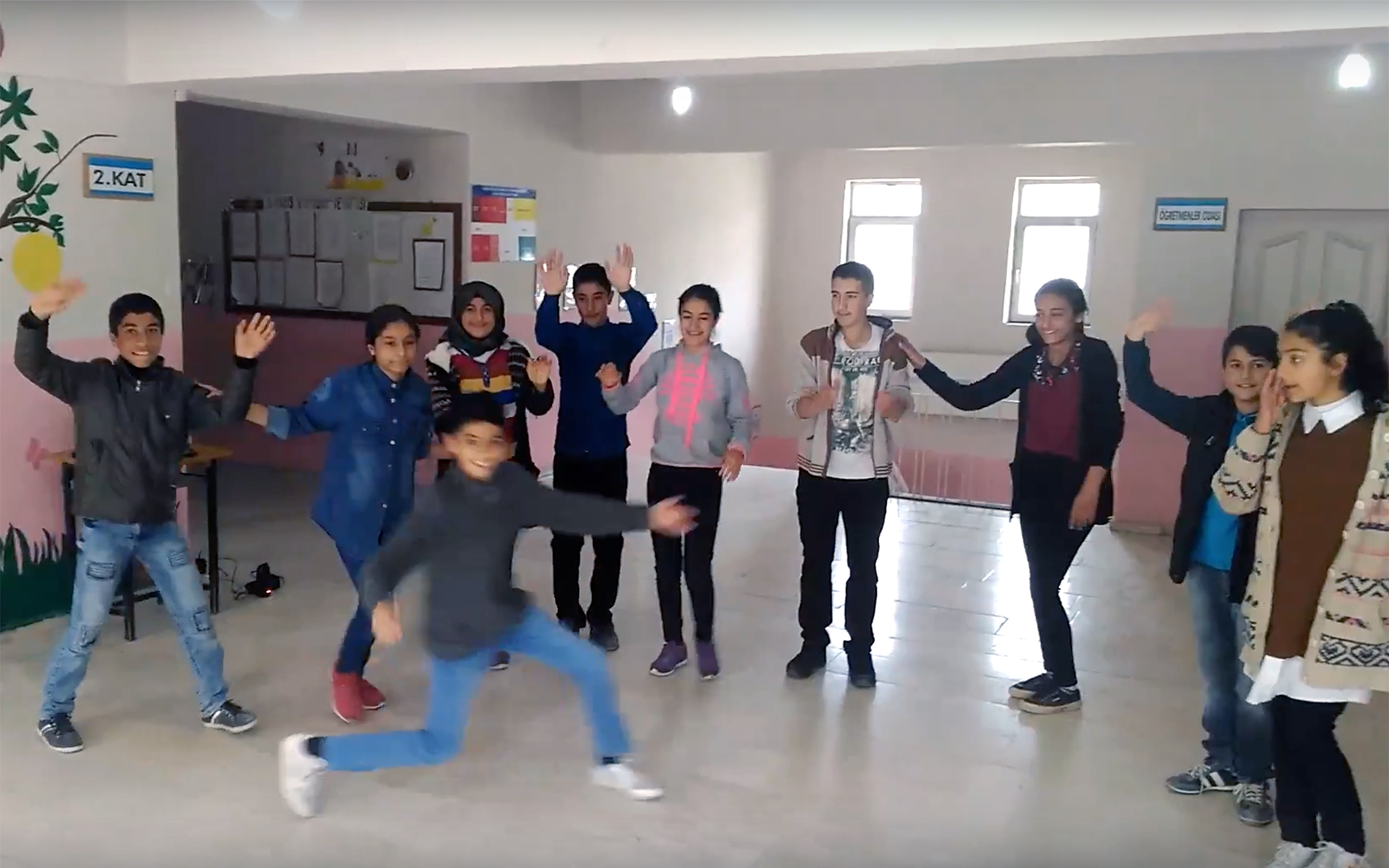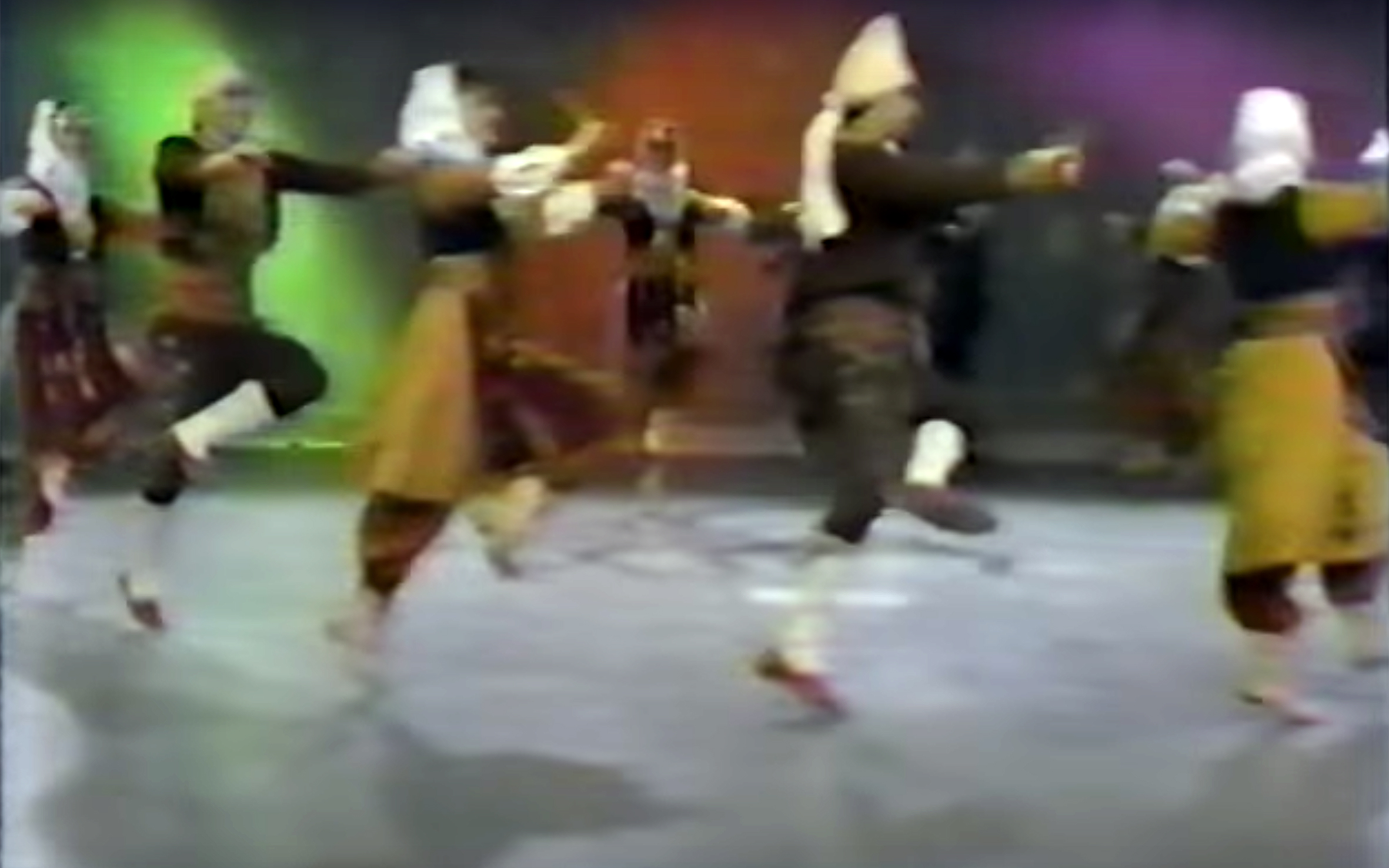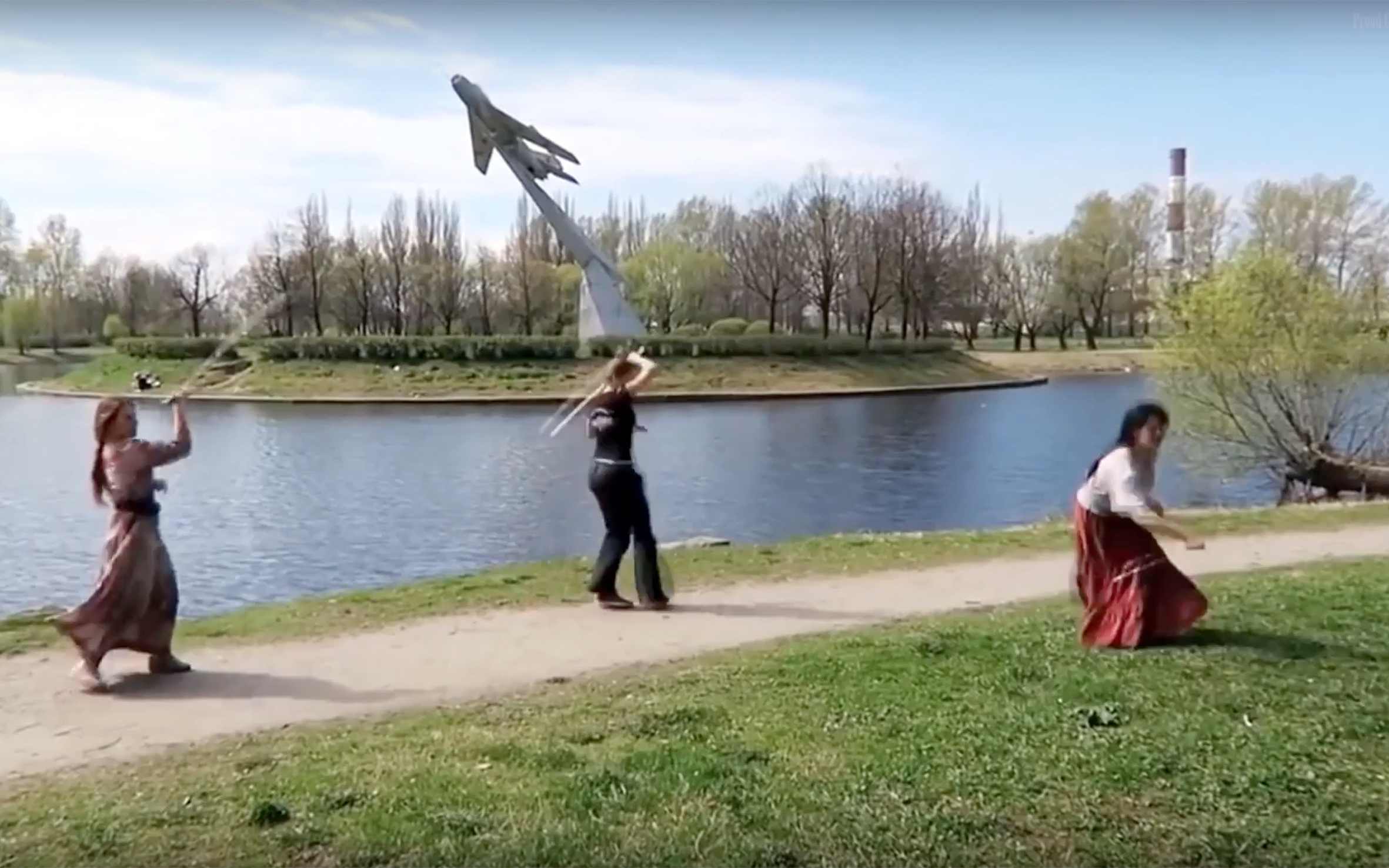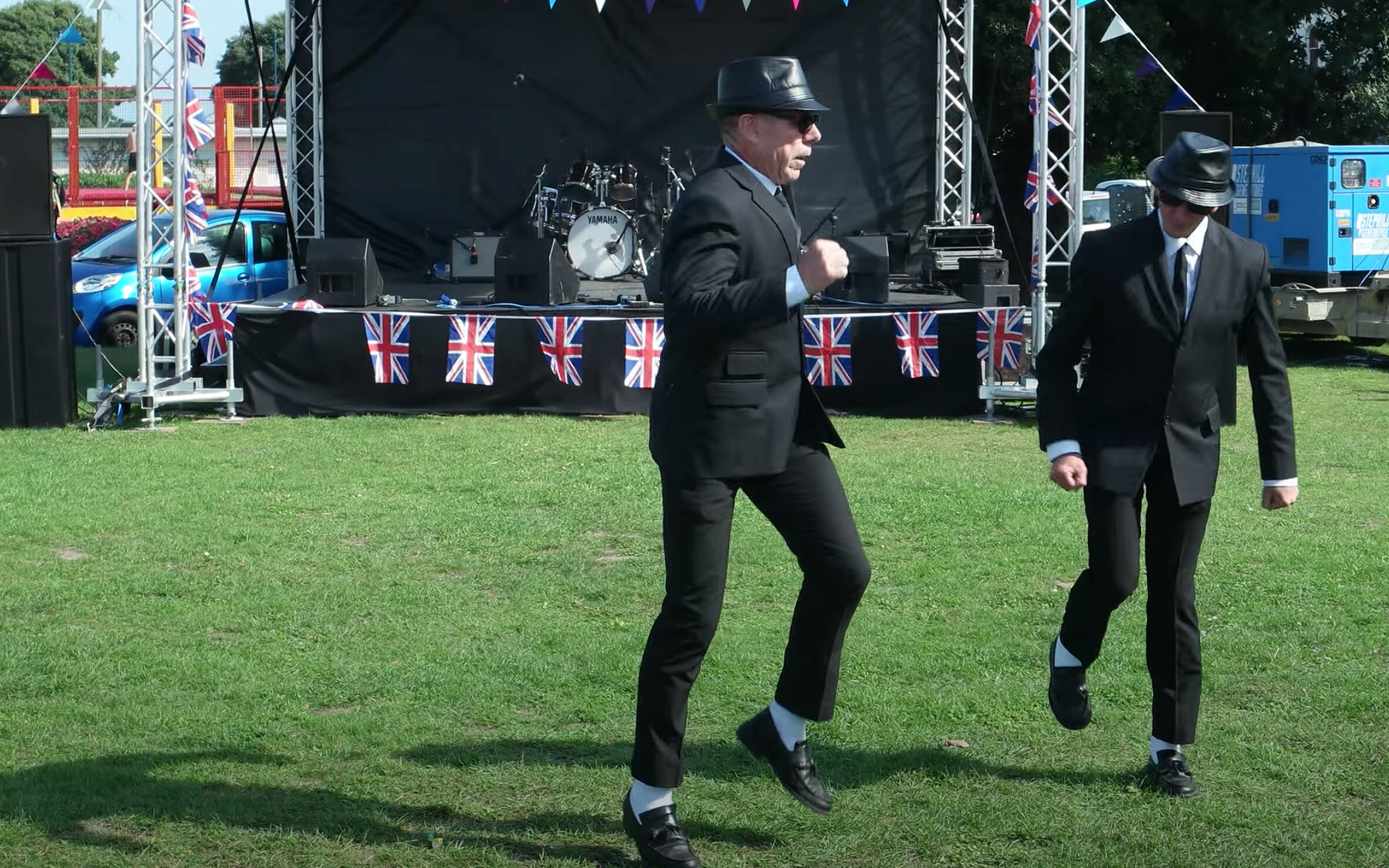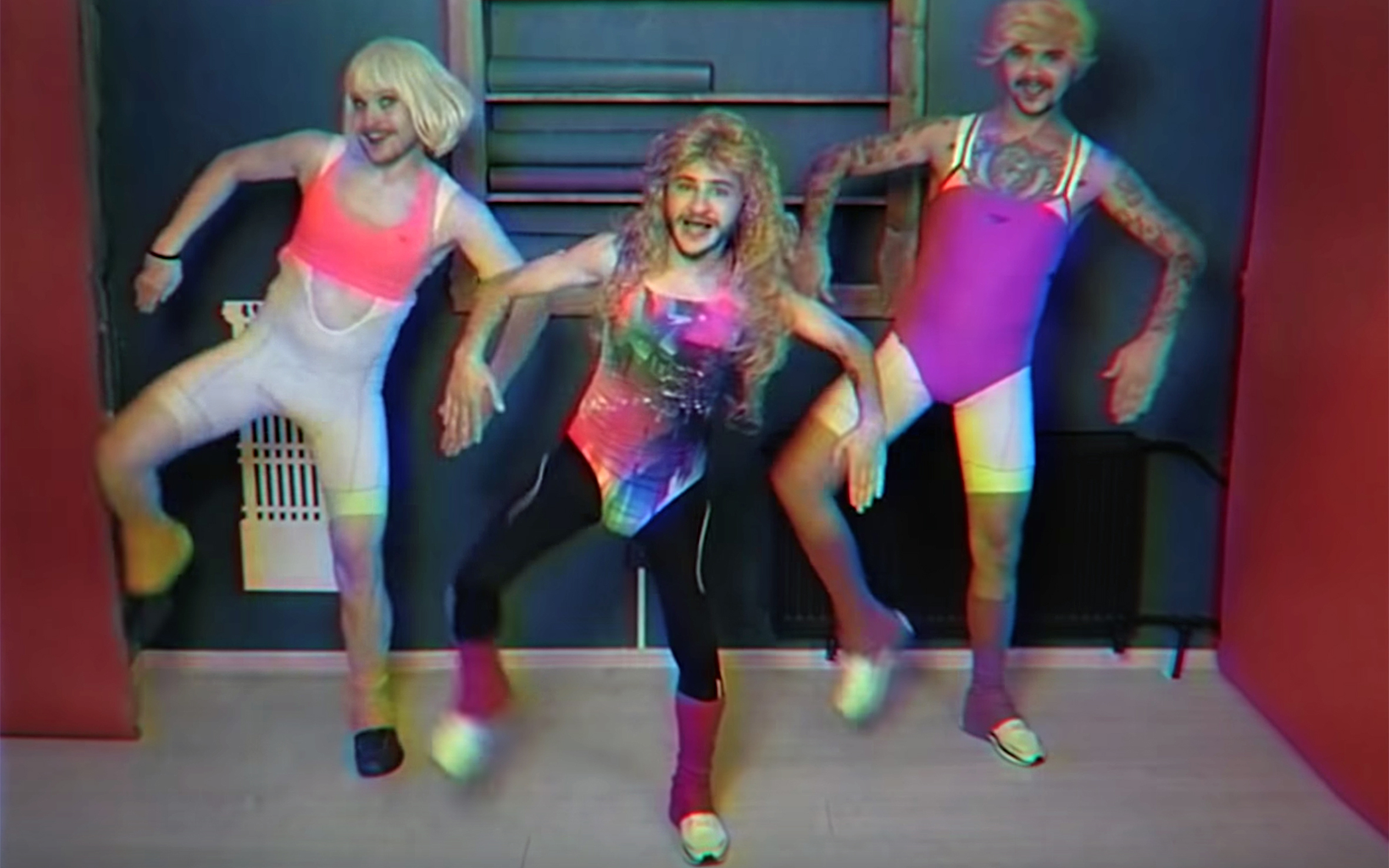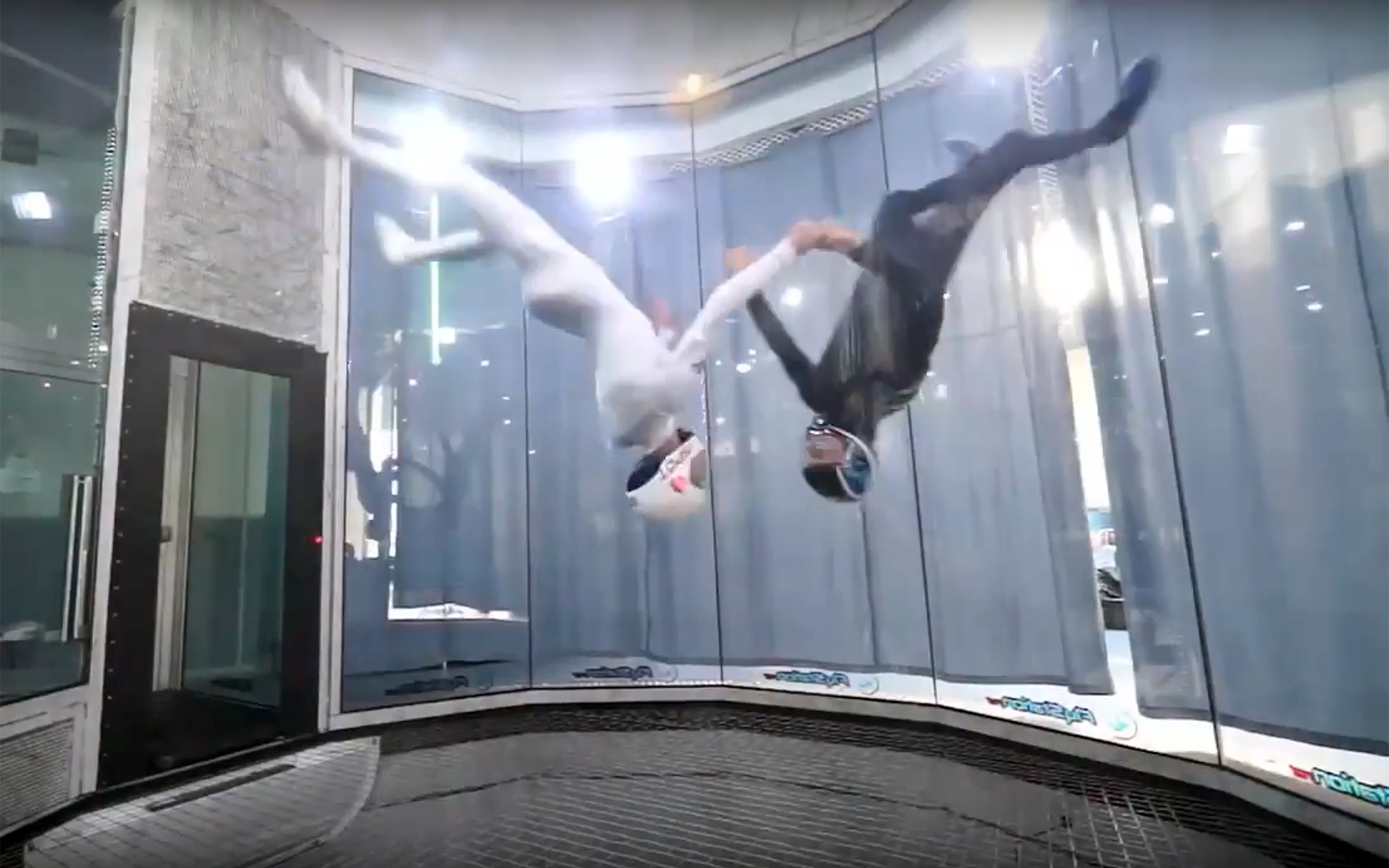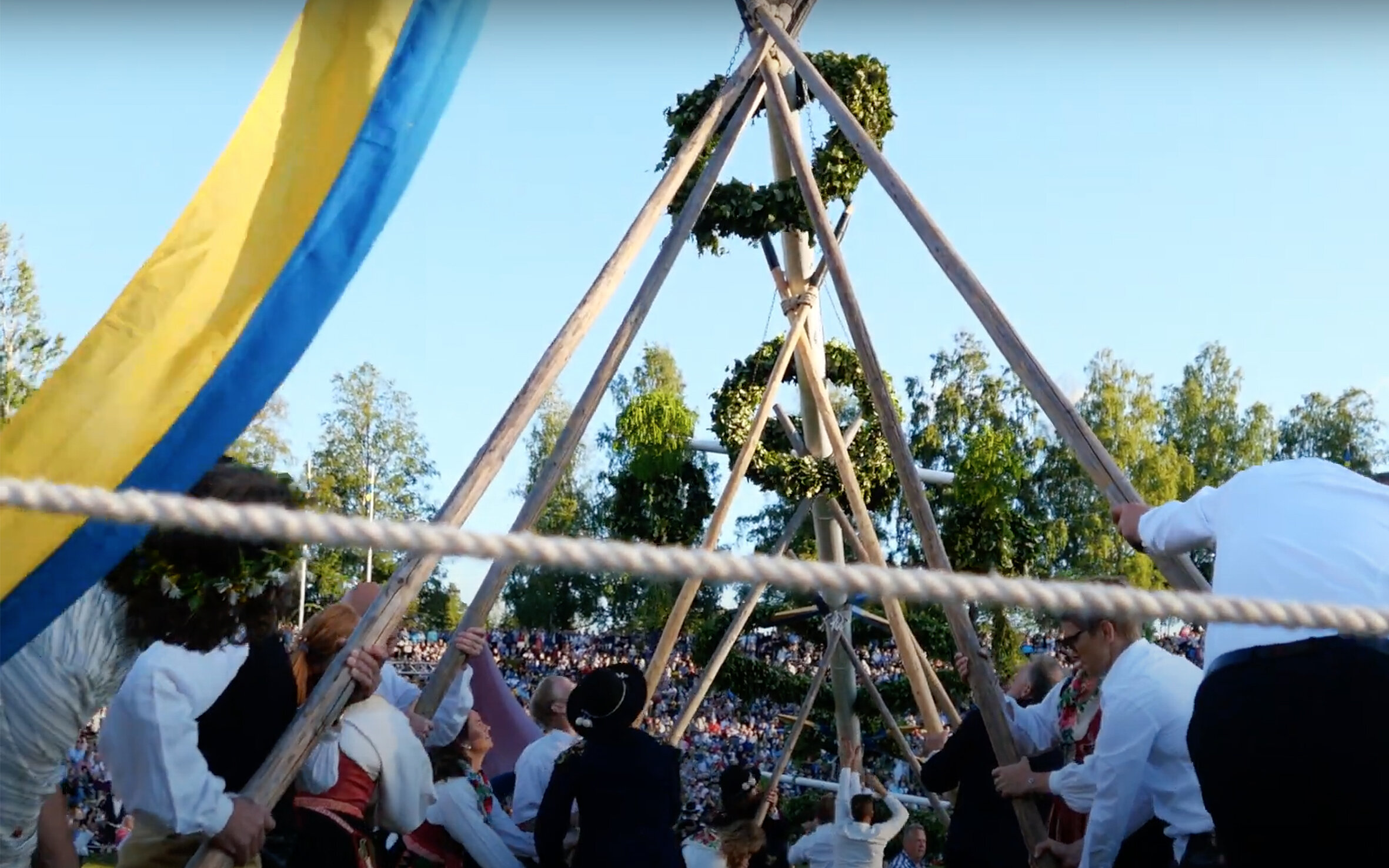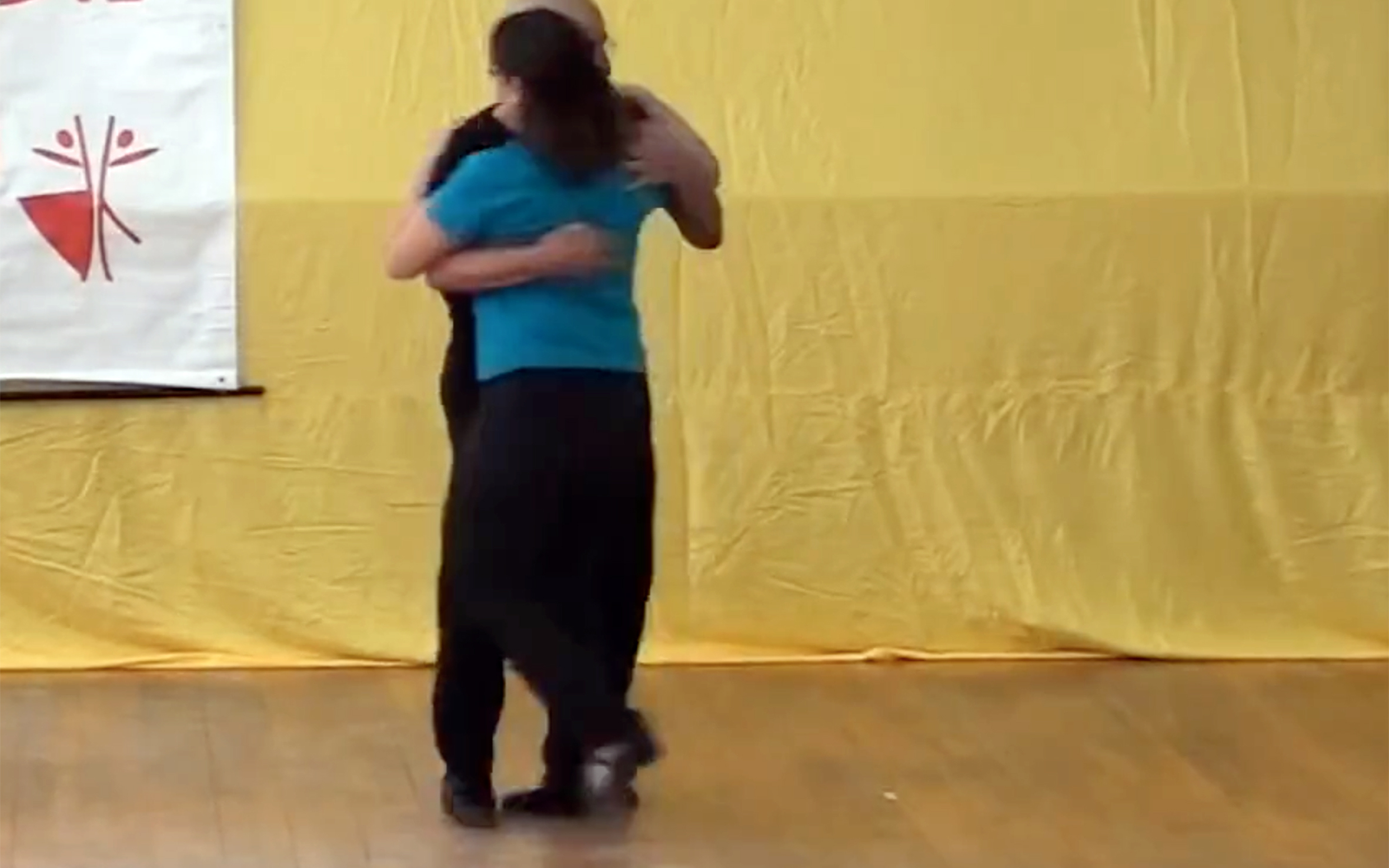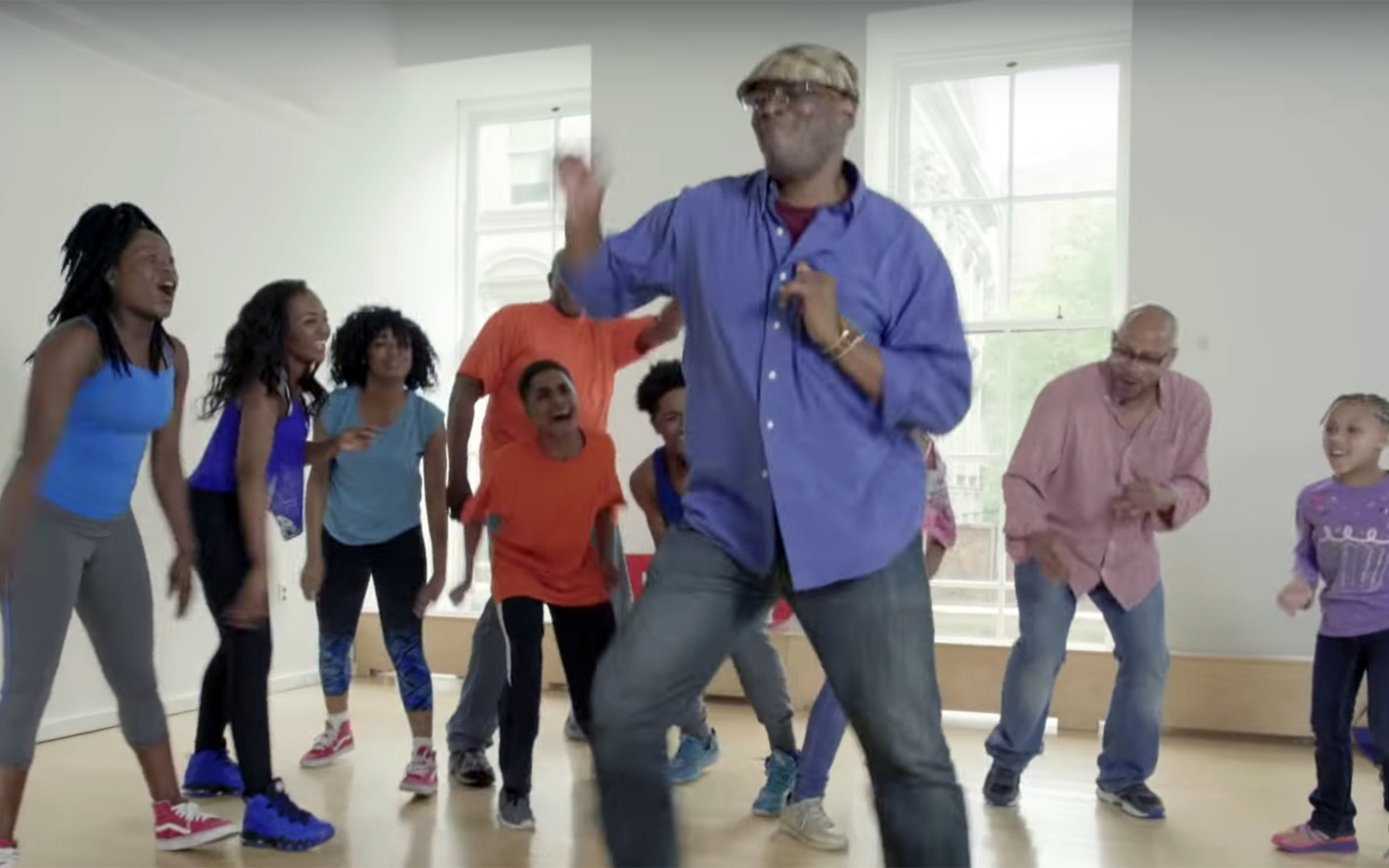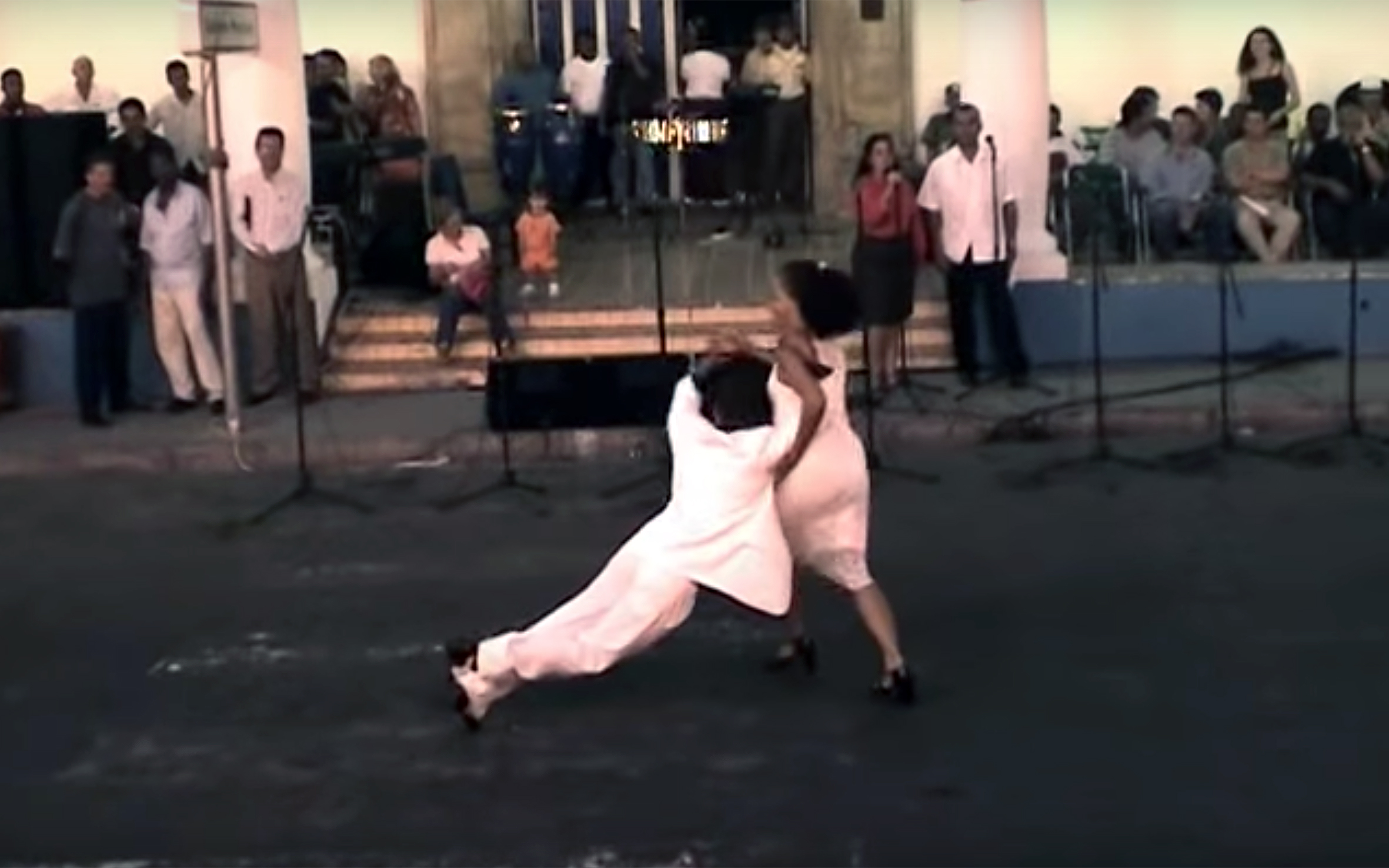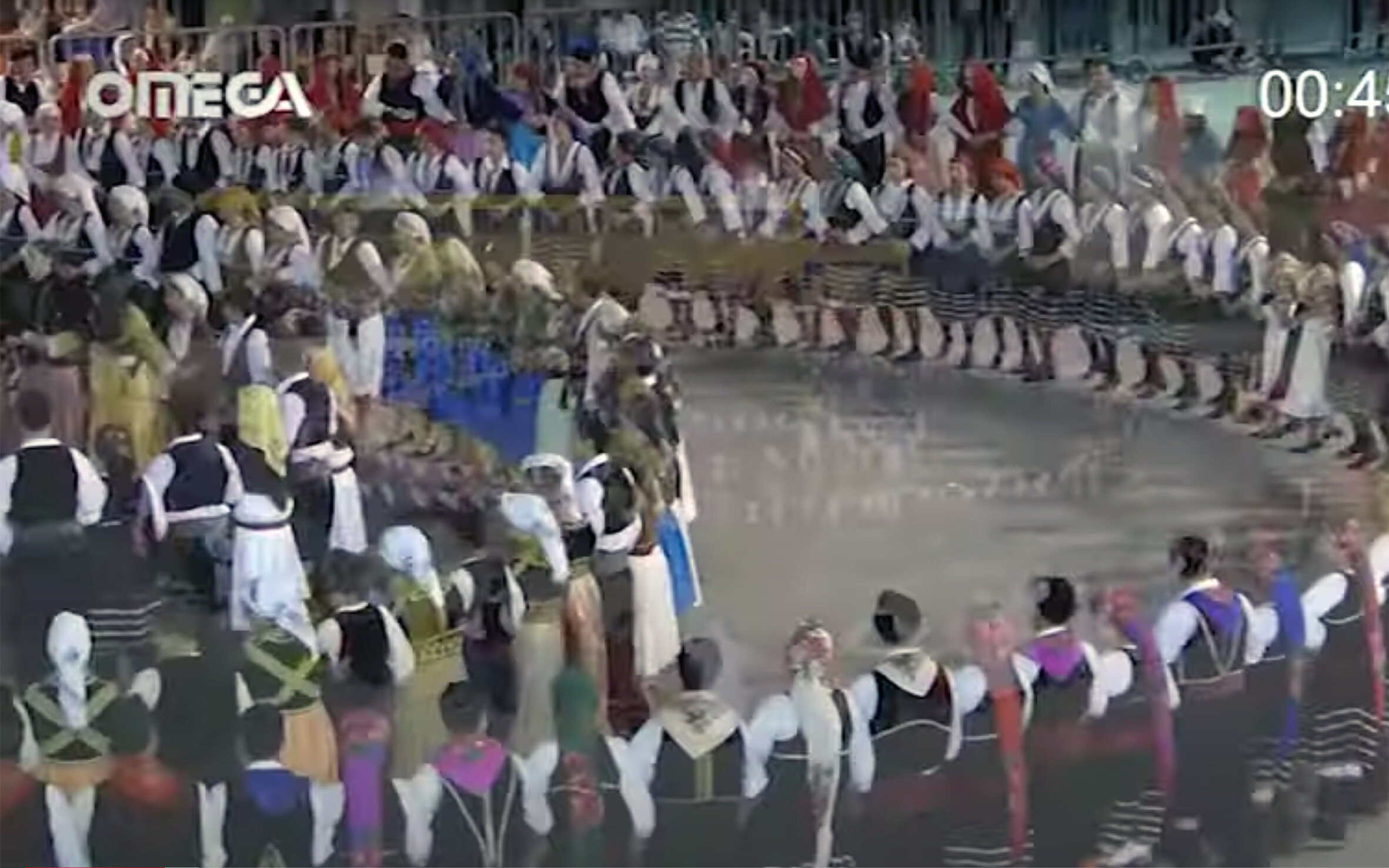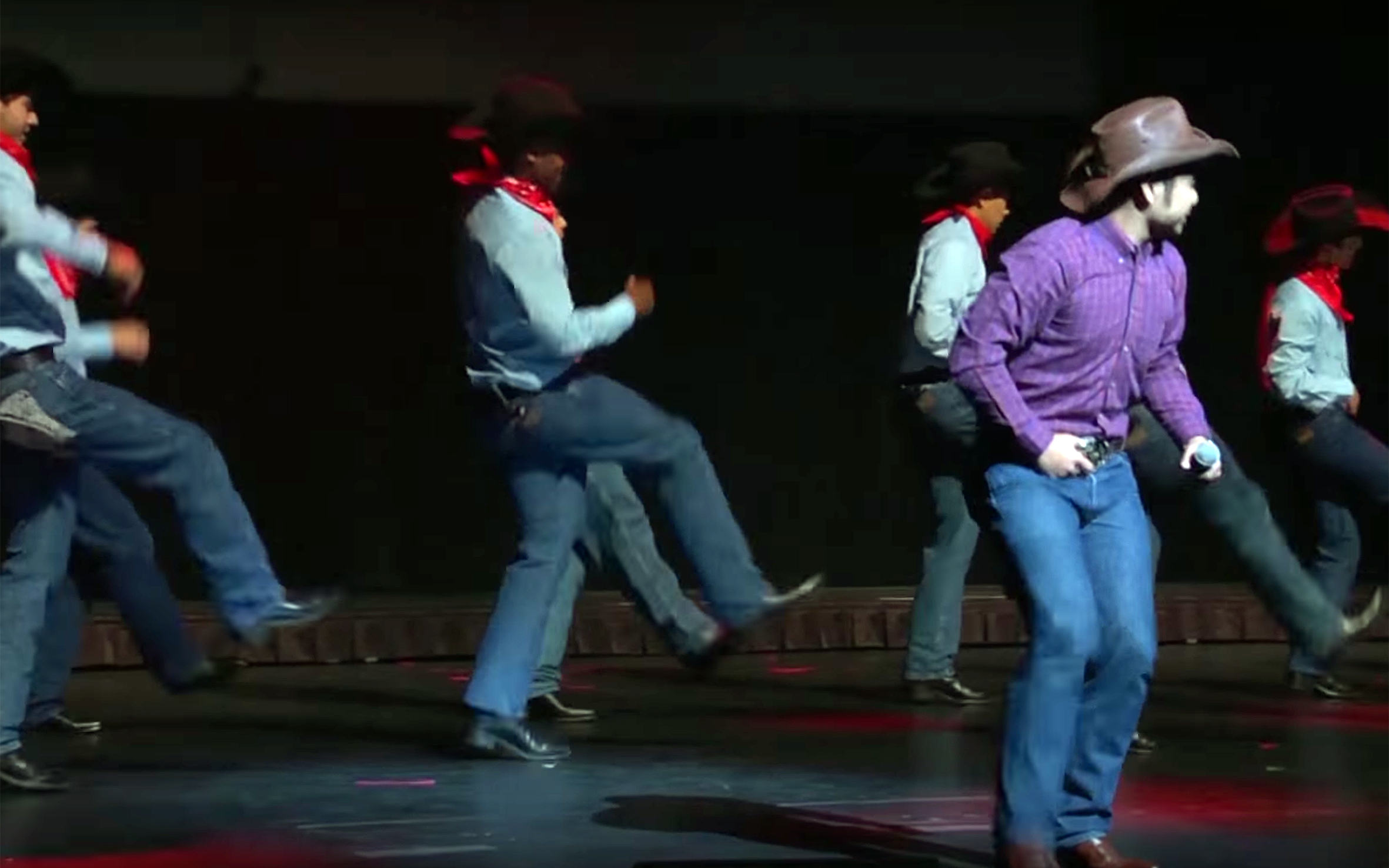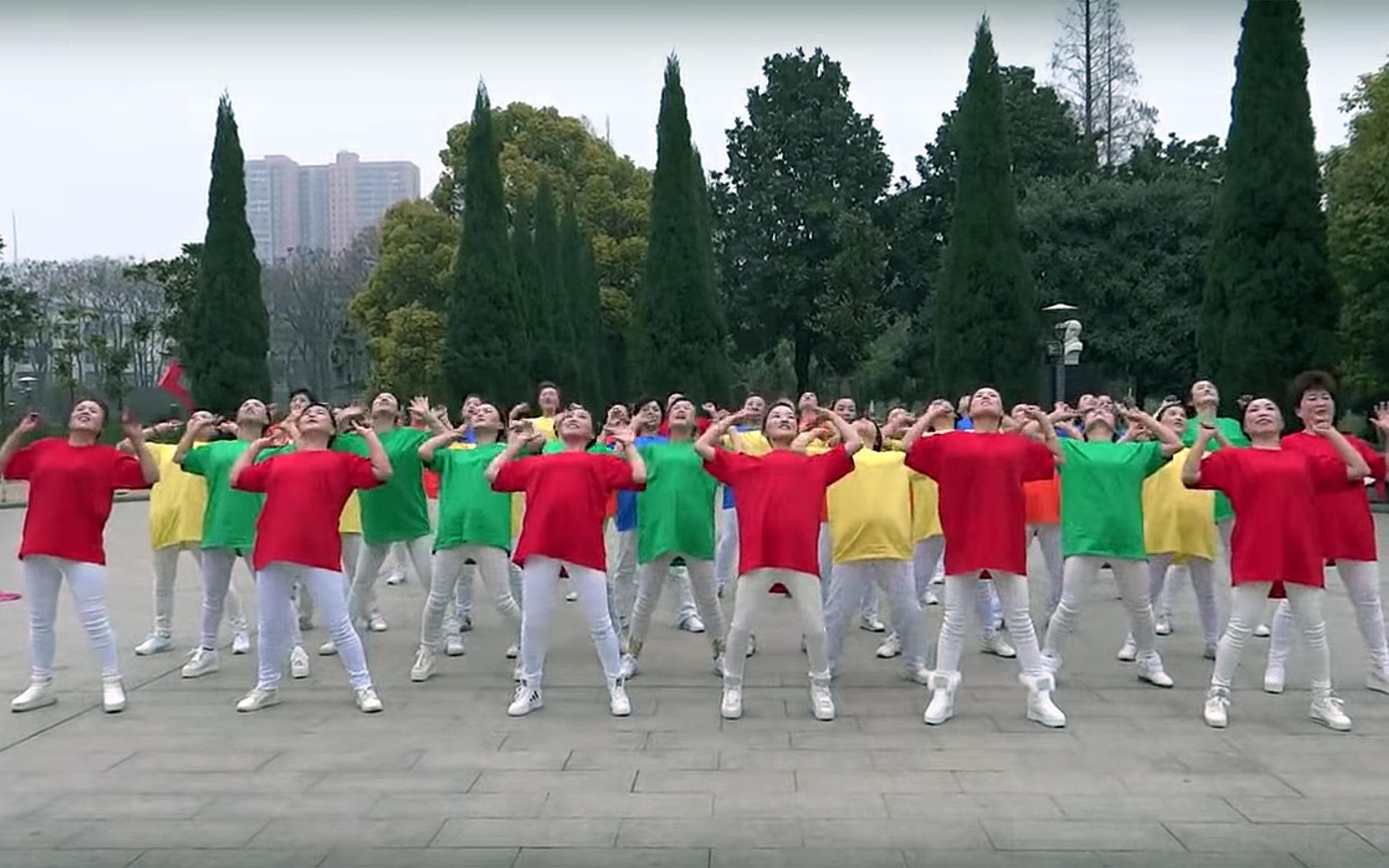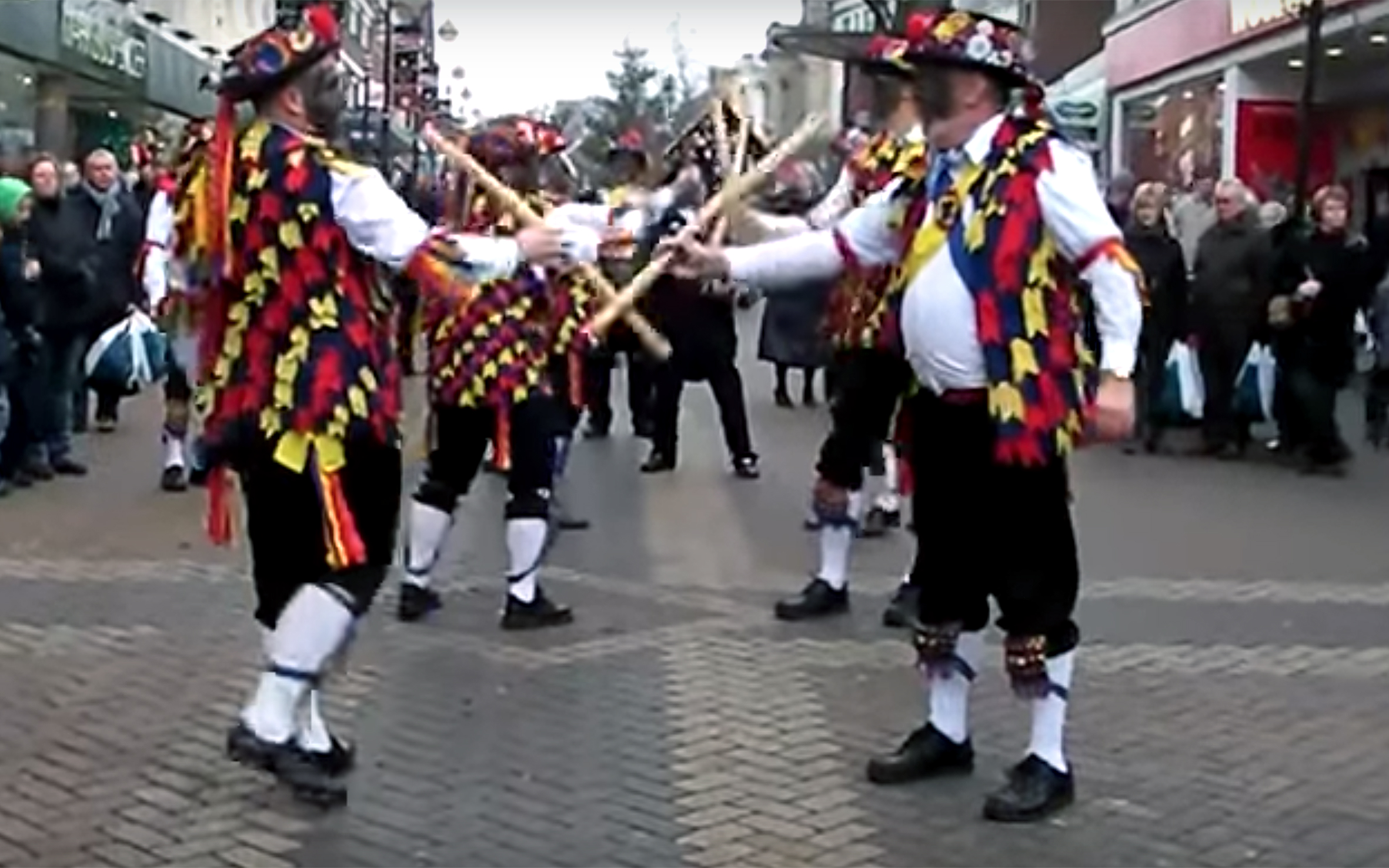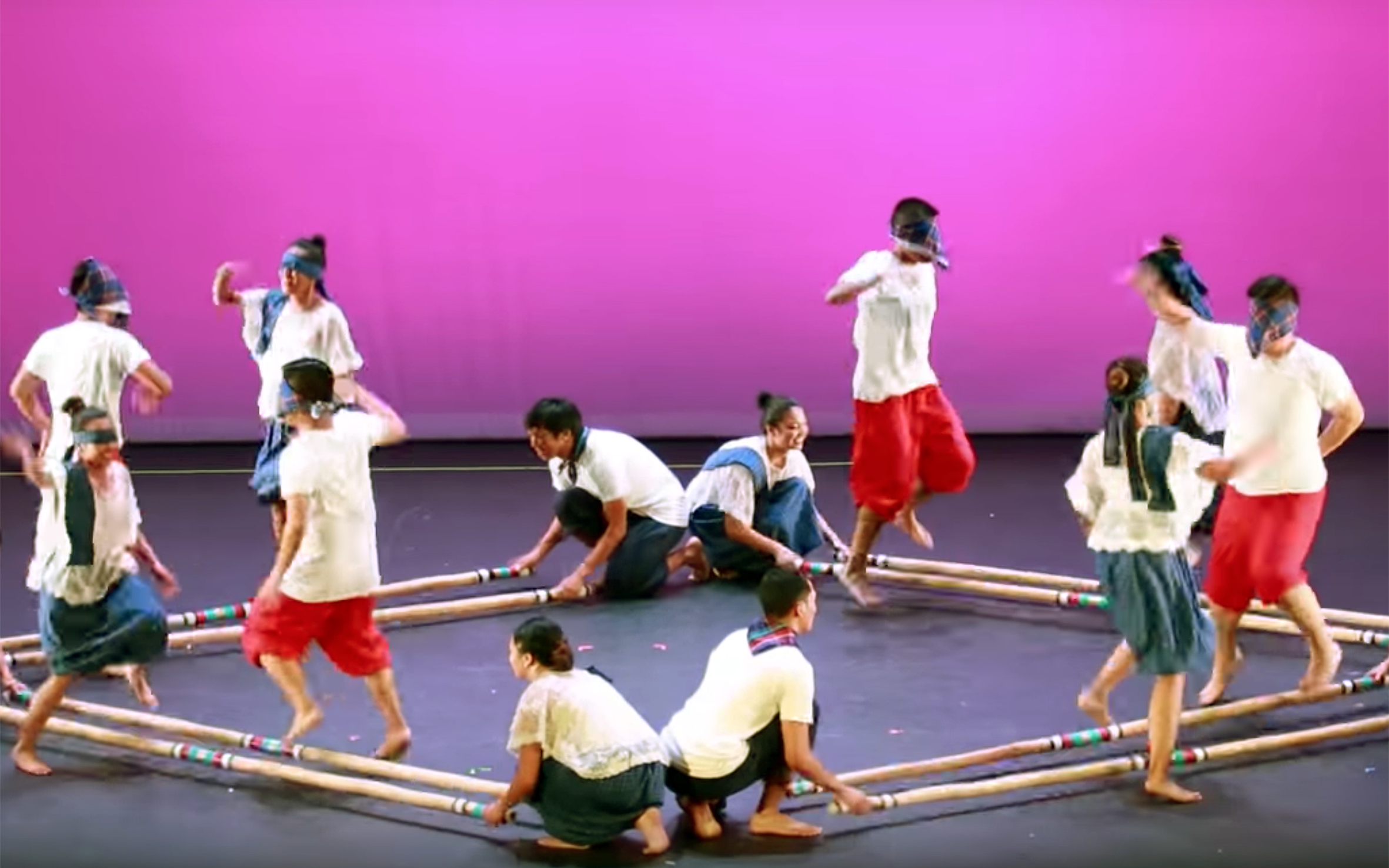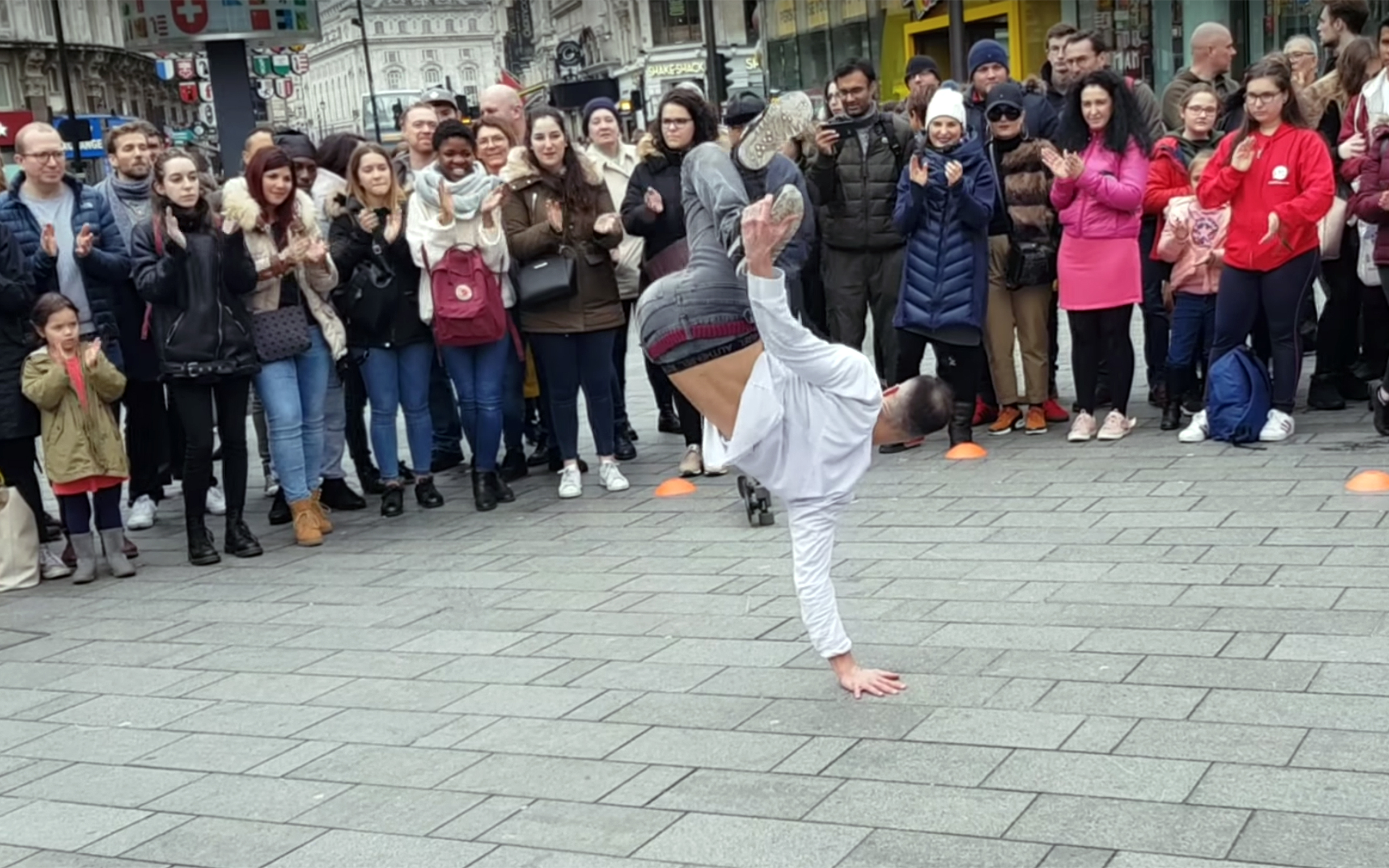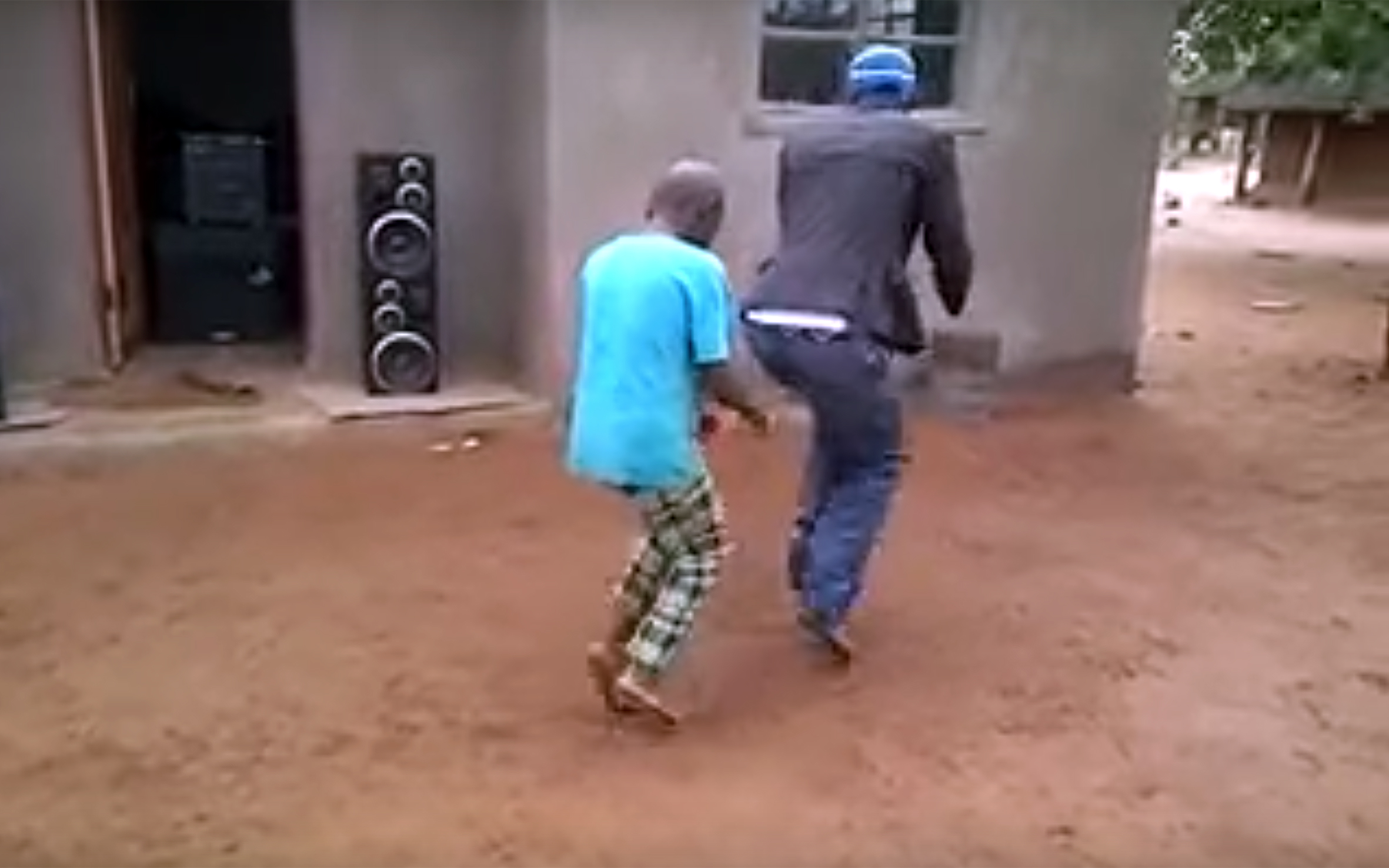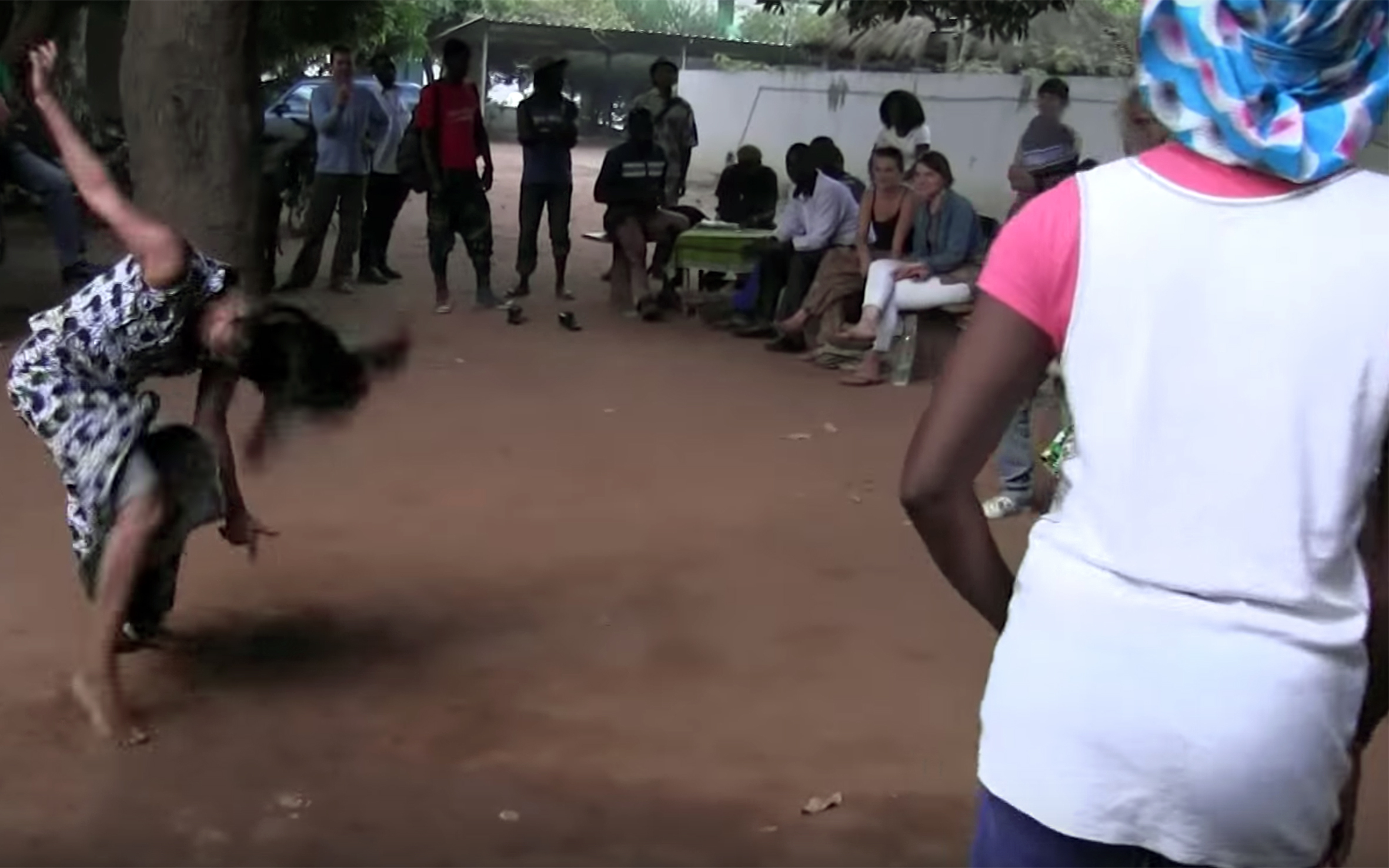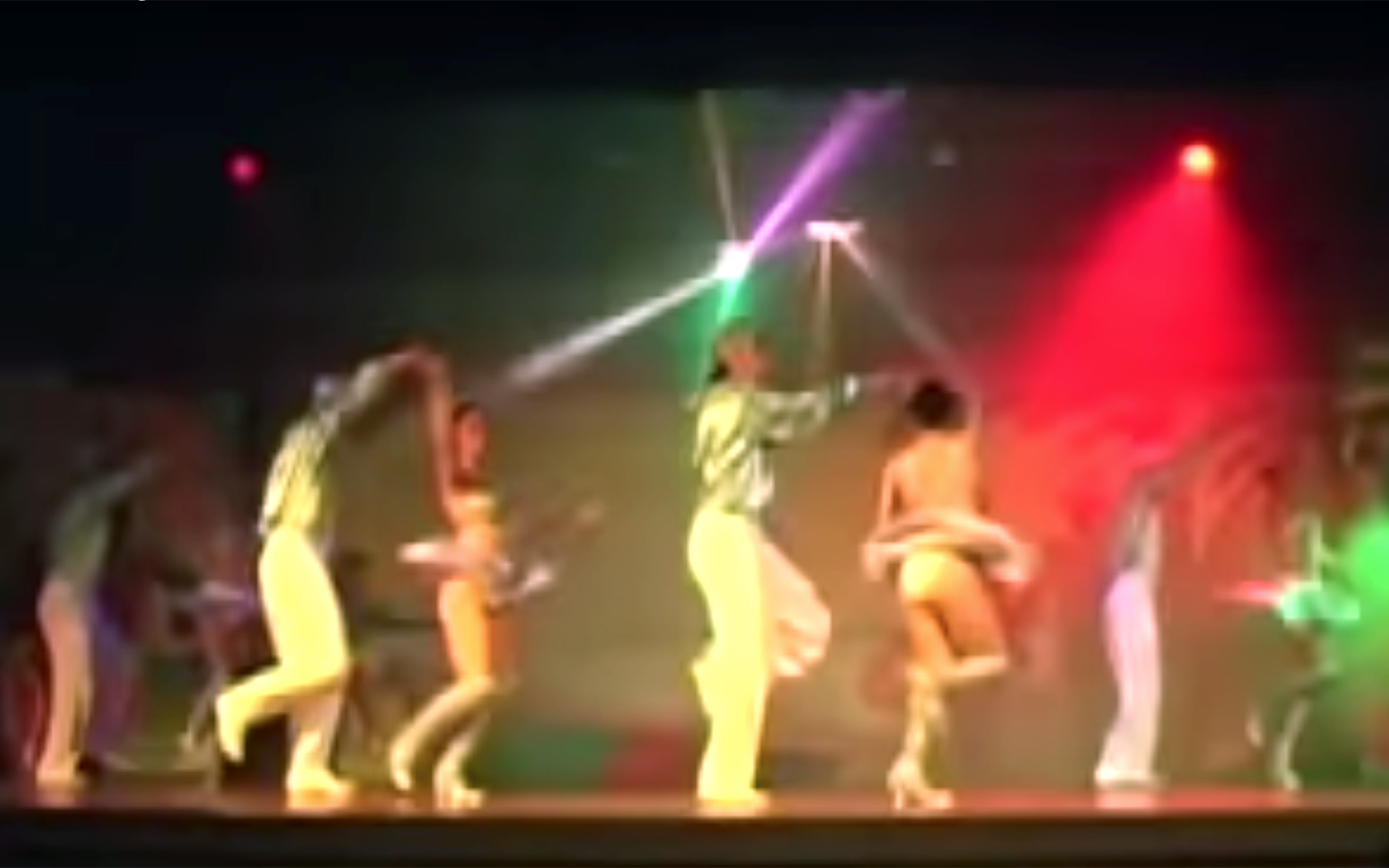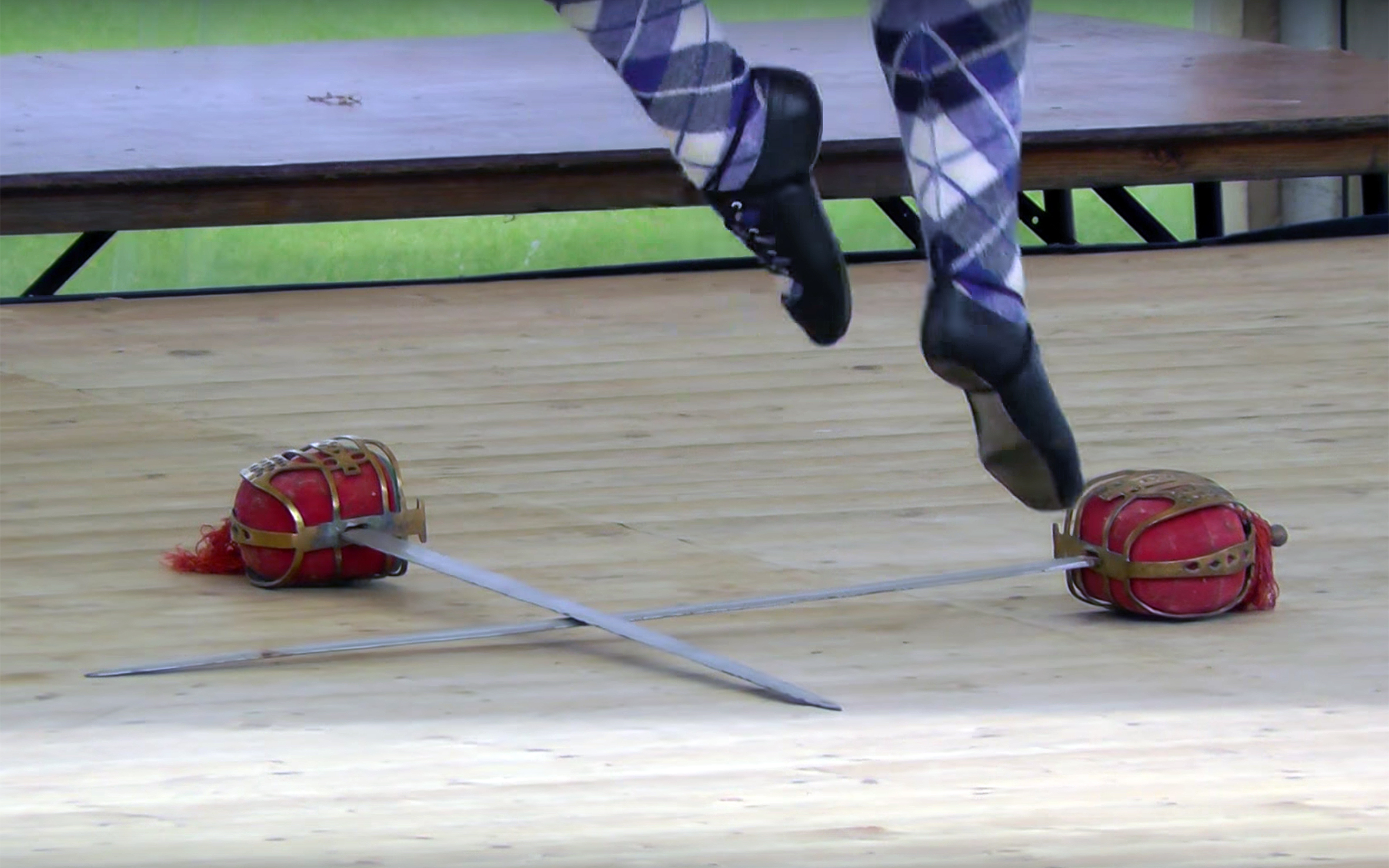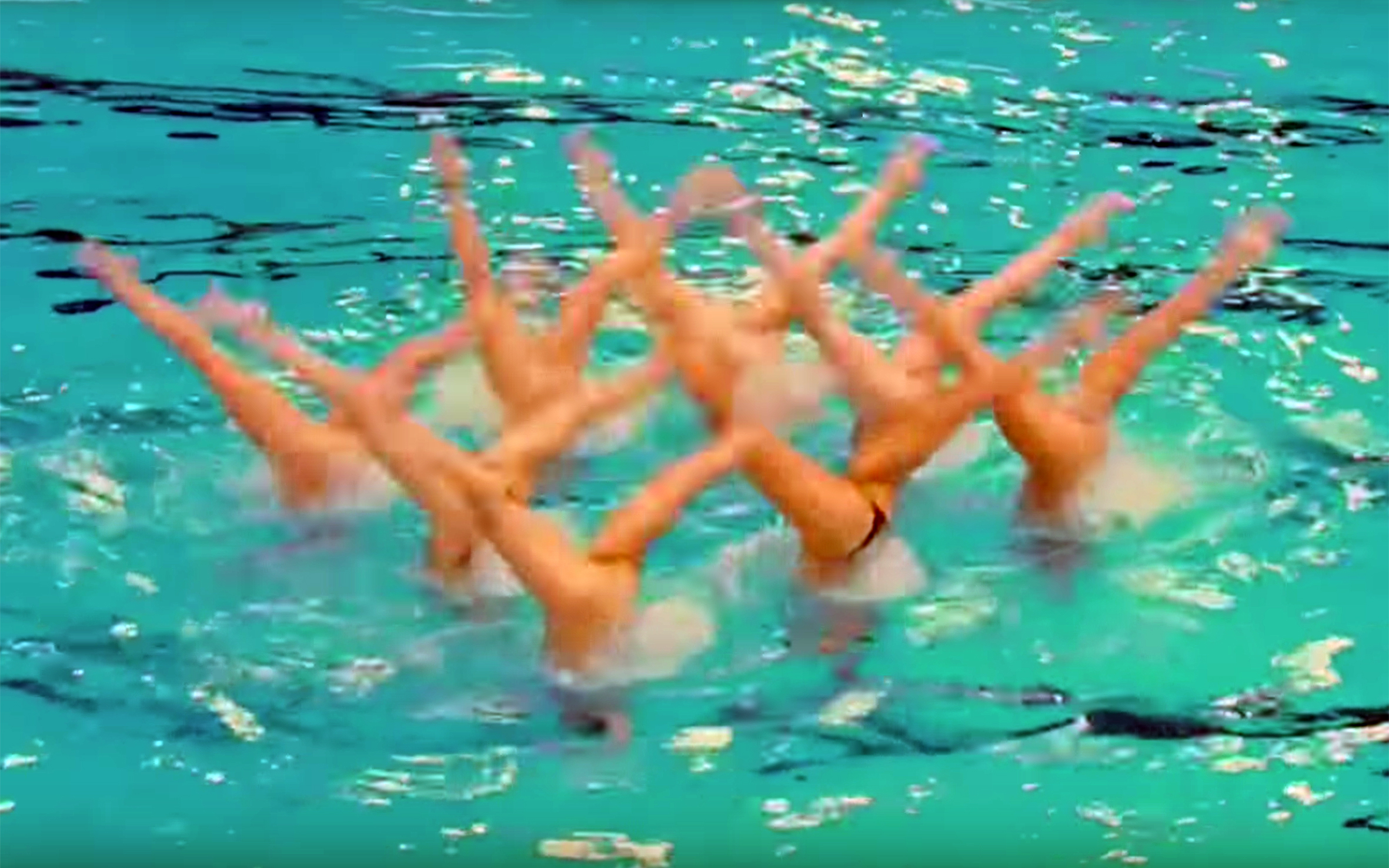768.SABAR / Guinea
SABAR is an energetic dance from Guinea. Sabar dancers hurl their legs and arms back and forth with phenomenal intensity, sometimes do rapid-fire turns and often explode into the air in jumps.
769.Shad Nongkrem / India
SHAD NONGKREM is the most important festival of the Khasis in Meghalaya, India, a five day long colorful celebration held annually in November at Smit, the capital of the Khyrem Syiemship near Shillong. It is an occasion for thanksgiving to the all powerful goddess Ka Blei Synshar for a rich harvest and for the prosperity of people. Young lads brilliantly clad in colorful silk dhotis, coat and a plumed turban, adorning glittering ornaments dance around with a sword or spear in one hand and usually a white Yak hair whisk in their left hand. Pretty maidens in magnificent silk-robes and elaborately decked in priceless intricately designed ornaments of gold and silver, wearing a silver crown, move in the inner circle in twos and threes taking tiny steps while the lads form the protective ring around them and flash their weapons.
770.Shad Suk Mynsiem / India
SHAD SUK MYNSIEM is celebrated in the month of April as a prayer to mother nature for a good harvest and for fresh sowing of seeds. Both men and women participate in the dance. The dance begins with drums, flutes and cymbals picking up the tempo. Two circles are formed with women on the inside and men on the outside. With eyes down, the women take small steps forward and backward as they gradually shift sideways to move in a circle. The men do a more energetic dance with swift movements in a clockwise and anticlockwise direction around women. Ka Shad Suk Mynsiem is symbolic of women fertility where they are the receptacles of seeds and bearers of fruit, and men are cultivators who plant, cultivate and nurture the seeds until they are harvested.
771.Saila / India
SAILA is a stick dance performed by the Gond tribe during the post-harvest season. Chhattisgarh has a considerable population of tribal people. Majority of them are directly or indirectly dependent on agriculture. Thus, harvest seasons are of utmost importance and are celebrated with much enthusiasm and dances.
772.Sajuriana / Chile
SAJURIANA is a dance from Chile. Its choreography consists of a confrontation of the dancers, who, at the beginning of the song, make a complete turn, turning the woman to the right, in three quarters of an imaginary circle, and the man, in the same direction. During the introduction, the performers follow the rhythm of the music with clapping. The lady takes her skirt with her left hand and the handkerchief with her right hand, holding it up a little above her head. The man can take it with both hands, making a pavilion over the head of his partner, moving with grace to the beat of the music. The music consists of two parts, corresponding to the couplet and the chorus, each formed by a regular binary period. The interlude of the melody possesses the same slight undulatory character as most Chilean folklore dances.
773.Salegy / Madagascar
SALEGY is a traditional dance of the Malagasy people from the northern Madagascar, danced by various ethnic groups. There are numerous styles of Salegy dance with moves often inspired by planting crops and protecting cattle. Popular Salegy Groove is an energetic, upbeat dance, that shares the hip- and booty-shaking style with some Latin dances.
774.SALSA / Global
SALSA is a popular form of social dance that originated in the Caribbean. Its movements have origins in Puerto Rican bomba and plena, Cuban Son, cha-cha-cha, mambo and other dance forms. It originated in the mid-1970s in New York. Different regions of Latin America and the United States have distinct salsa styles of their own, such as Cuban, Puerto Rican, Cali Colombia, LA and New York styles. Salsa dance socials are commonly held in night clubs, bars, ballrooms, restaurants, and outside, especially when part of an outdoor festival. In many styles of salsa dancing, as a dancer shifts their weight by stepping, the upper body remains level and nearly unaffected by the weight changes. Weight shifts cause the hips to move. Arm and shoulder movements are also incorporated.
775.SALTARELLO / Italy
SALTARELLO is a popular folk dance played in the regions of Southern- Central Italy, such as Abruzzo, Molise (but in these two regions the name is feminine: Saltarella), Lazio and Marche. The dance is usually performed on the zampogna bagpipe or on the organetto, a type of diatonic button accordion, and it is accompanied by a tambourine.
776.Samaia / Georgia
SAMAIA is a traditional Georgian dance performed by three women, said to be originating from the pagan times. However, nowadays it is seen as a representation of King Tamar and her glory. King Tamar in many sources is mentioned as a Queen of Georgia. Nevertheless, she was considered to be the king of the United Kingdom of Georgia in the 12th-13th centuries and was the first woman king in Georgia’s history. The idea of the Trinity presented in the dance represents King Tamar as a young princess, a wise mother and a powerful king. All these three images are united in one harmonious picture. Moreover, simple yet soft and graceful movements create an atmosphere of beauty, glory and power that surrounded King Tamar’s reign.
777.Samba / Brazil
SAMBA is a lively, rhythmical dance of Afro-Brazilian origin in 2/4 time danced to Samba music whose origins include the Maxixe. It is a dance of black/African people in Brazil who brought much of their music and dance culture into Latin America upon their arrival into many Latin American countries. Samba music is very similar to and has been influenced by many Angolan music genres. It has also been influenced by many other Latin American music genres and dances. The Samba music rhythm has been danced in Brazil since its inception in the late 16th century. There is actually a set of dances, rather than a single dance, that define the Samba dancing scene in Brazil; however, no dance can be claimed with certainty as to the “original” Samba style.
778.Samia / Uganda
SAMIA DANCE is a traditional dance performed by the Samia people from eastern Uganda on happy occasions.
779.SAMO / Burkina Faso
SAMO DANCE is a traditional dance of the Samo people living in northwest Burkina Faso.
780.San Dance / Botswana / Namibia
SAN DANCE is a hunting and gathering dance (sometimes referred to as the rain dance) which the Sarwa tribe use to celebrate for good hunts, while the Tswana ethnic group use it for rain making or “go fetlha pula”. The Basarwa are classified as hunter-gatherers, therefore they perform the rain dance as a celebratory dance to thank gods for every successful hunt.
781.SAO MAKO / Wallis & Futuna
SAOMAKO is a traditional warrior dance from Wallis and Futuna, French Territory. It has been described as an informal type of dance accompanied by continuously accelerating music, the final speed of which was limited only by the energy of the singers and dancers. Soamako of today, is performed as a “combat dance” between two groups of dancers who enter from opposite sides alternately and try to better the performance of their opponents. It is performed as a group dance at special occasions such as weddings, festivals, anniversaries and celebrations.
782.Sârba / Romanian
SÂRBA is a Romanian dance usually played in 2/2 or 2/4 time. It can be danced in a circle, line, or couple formation, and it was historically popular not only in Romania but also in Serbia, Ukraine, Hungary, among Polish highlanders (Górals) and Ashkenazi Jews. It is fast-paced and triplets are usually emphasized in the melody. The dance is still popular in Romanian traditional music and in Jewish Klezmer music. It was named after the Serbs.
783.Sardana / Spain
SARDANA is a circle dance from Catalonia—the national dance from this region. Originally from the Empordà, it became popular in Catalonia during the 20th century. There are two main types, the original “sardana curta” (short sardana) and the more modern “sardana llarga” (long sardana), which is more popular. The origin of the sardana is not clear. Modern choreography was established at the end of the 19th century. Dance circle can be opened to a highly variable number of dancers, alternate men and women, with the man’s partner on his right. Usually an experienced dancer leads the circle with dancers holding hands—arms down during the curts and raised to shoulder during the llargs. Traditionally shoes called espardenyes were used for dancing, made of esparto grass fabric, with two long fabric strips tied up around the ankle.
784.SARDINIAN Dancing processions / Italy
SARDINIAN DANCING PROCESSIONS are typical celebrations on the island. Among them is the traditional carnival masquerade parade of Mamuthones and Issohadores in Mamoiada. Twelve Mamuthones in two rows, surrounded by eight Issohadores, move in a way that has been described as a “dancing procession”, because of the grave yet musical, rhythmical pace they follow. Mamuthones move slowly, with heavy steps, as if they were chained. With their backs curved under the weight of the bells, dressed in coarse vests and grimacing masks, they rhythmically shake their right shoulder, advance the left foot, while the bells clang in unison. Issohadores move with agile, deft steps, surrounding the darker figures, guiding, and then confronting them. Mamuthones do not interact with the crowd, while Issohadores skip across the road, catching young women with the slim reed rope (soha).
785.Sau Sau / Easter Island
SAU SAU is a dance of Samoan origin that came to the island in the 1940s and was modified with Rapa Nui music and lyrics. It represents an amorous story about a boat rocked back and forth by the waves, which is represented by undulating movements of hips and hands, especially by women who wear colorful feathers. It has become one of the main Rapa Nui dances, a must in any celebration.
786.Saudi penguin dance / Saudi Arabia
SAUDI PENGUIN DANCE is a dance that became very popular at weddings and among children in Saudi Arabia, despite the country being very conservative. Its popularity stems from the fact that Saudi Arabians are some of the biggest users of YouTube, so the penguin dance became viral across the platform. Its steps imitate the steps of a penguin.
787.SAVELUGU DANCE / Ghana
SAVELUGU DANCE is a dance by a dance group from Savelugu, a village near Tamale in the Northern Region of Ghana.
788.Saya / Bolivia
SAYA is an Afro-Bolivian folkloric dance. It can be considered as the product of the fusion of African, Aymara and Spanish elements. The accompaniment of drums and guanchas and the couplets between soloist and choir emerge from the African roots, while the dress adopted by the women resembles the dress of the Aymara women. The song is performed in Spanish.
789.Sayaw Sa Bangko / Philippines
SAYAW SA BANGKO is a famous Pilipino folk dance in which the dancers must use good skill and balance as they dance on top of a narrow bench. This dance dates back to before the Spanish colonisation of the Philippines, which means it is a purely Pilipino ancestral dance. Dancers showcase their skills as they dance atop a narrow bench, while constantly trading places. As opposed to competing with each other to stay on the bench, dancers must complement each other to ensure that they do not fall. This dance is usually performed in town fiestas.
790.Schacshas / Peru
SCHACSHAS is a dance of Ancash, region north of Lima in Peru, performed on the occasion of religious festivals, such as the Lord of May in Huaraz and the Virgin of the Assumption in Chacas or the province of Corongo, specifically in the district of Aco. It is also present in Lima in school competitions, various shows and celebrations.
791.Schottische / Global
SCHOTTISCHE is a partnered country dance that apparently originated in Bohemia. It was popular in Victorianera ballrooms as a part of the Bohemian folk-dance craze and left its traces in the folk music of countries such as Argentina (“chotis” and “chamamé”), Finland (“jenkka”), France, Italy, Norway (“reinlender”), Portugal and Brazil (xote, chotiça), Spain (chotis), Sweden, Denmark (“schottis”), Mexico (Norteño music), and the United States. Its basic step is made up of two side steps to the left and right, followed by a turn in four steps. The European version is typically danced to faster music and is quite restrained in its movements. The American one is often large and open, with the first part expressed equally as promenades, individual or led twirls or similar moves, and the second part most often expressed as a close pivot.
792.Schuhplattler / Germany / Austria / Italy
SCHUHPLATTLER is a traditional folk dance popular in the regions of Bavaria and Tyrol (southern Germany, Austria and the German speaking regions of northern Italy). The performers stomp, clap and strike the soles of their shoes (Schuhe), thighs and knees with their hands held flat (platt). More than 150 basic Schuhplattlers, as well as marches and acrobatic feats, are often interspersed with the basic dance performance. It is danced today in Europe and in German immigrant communities around the world. While the Schuhplattler is still largely performed by adults, it has become increasingly popular with youngsters, who love its colourful costumes and its bouncing, leaping, kicking and choreographed show-offs.
793.Schunkeln / Germany
SCHUNKELN is a word in German used to describe a certain rhythmic movement to the beat of a song—people link arms and sway side to side on the spot. It can be done either standing or sitting, with people moving side to side on their seats via the upper body. Sometimes people will also move backwards and forwards, with stand-up sit-down movements. It is a popular dance in German speaking countries at Oktoberfest where Volksmusik and the popular folk music is played. It is also performed by audience members on TV shows such as “Musikantenstadl”.
794.Sean Nos Dance / Ireland
SEAN NOS DANCE is a form of Irish dancing that originated from the western regions of Ireland. It has been described variously as a regional style of step dancing, and as an entirely separate style that was virtually unknown outside small areas until the late 20th century. It is distinguished by footwork which is percussive but low to the ground in comparison to step dancing, and by its more freeform nature.
795.SEGA / Reunion Island / Madagascar / Mauritius
SEGA is the most famous dance on the Indian Ocean islands, such as Madagascar, Mauritius and Reunion Island. It originated from the ritual music of Madagascar and the mainland of Africa, and it is the musical expression of the Mauritian way of life: joy and liveliness. Originally sung by men and women who had been sold as slaves but whose souls had remained sensitive to music, the Sega is nowadays a folk song which has integrated itself within the framework of the local folklore. It is a two-person dance—a woman leads and a man follows her movements.
796.SEKSMANNSRIL / Norway
SEKSMANNRIL translates to 6-man Reel and is a bright, lively 3-couple set dance. As with several other folk dances of similar nature in Norway, it is generally considered to have been an import from Scotland centuries ago, but over the years has acquired a typically Norwegian character.
797.Semah / Turkey
SEMAHis a religious ritual folk dance performed by the Alevi and Bektas¸i communities. Performed by turning and whirling with divine love, the dance is called “turning semah”.
798.SEMBA / Angola
SEMBA is a rhythmic form of music and dance from Angola, born in the 20th century at the creative intersection of traditional African dance and colonial European influence. Its characteristic rhythm is one of the main contributors to kizomba music. Semba was played by small bands in Angola at large gatherings. The word “semba” comes from “massemba” meaning “a touch of the bellies”—one of the most recognizable and entertaining movements in semba. It is a walking based dance, with a range of tempos, from slow and relaxed to blisteringly fast, and with the undeniable energy. It can be linear or move around the lead. The hold is similar to a ballroom hold, although leaders lean forward or bend slightly at the waist, and ladies never lean back. Frequently it gets confused with Brazilian samba, since the names are similar.
799.Senile Dance / Global
SENILE DANCE is a dance performed by people of such an old age you would not expect them to still be able to dance.
800.SENIOR DANCE / Global
SENIOR DANCE is a dance performed by seniors—older people dance various dance styles, typical for the region they come from.
801.SENOUFO / Burkina Faso
SENOUFO DANCES are traditional dances performed by the Senoufo people from the southwest of Burkina Faso.
802.Sertanejo universitário / Brazil
SERTANEJO is a music and dance style that originated in the countryside of Brazil in the 1920s. It is one of the most popular music styles in Brazil, particularly throughout the southern/southeastern and centerwestern countryside. Its subgenres include sertanejo de raiz, sertanejo romântico, and sertanejo universitário. The dance itself is not very hard to learn and anyone can grasp its basics. It is danced in pairs and incorporates movements of various ballroom dances.
803.Setapa / Botswana
SETAPA is a traditional music and dance that originated from the Bangwaketse people of Kanye village and surrounding areas in Botswana. It involves a group of people stamping into the ground with their feet, to the song played or sung by a choir or a group. The word is derived from the Tswana word “Go tapatapa”, which means “to step into the ground continuously”. Setapa troupes involve an equal mix of both men and women, traditionally dressed up in the costumes made of animal skins. They also wear shells around their ankles to create a sound while dancing. Men usually carry whistles and heifer horns to make sound from the stream of air or as they blow into them.
804.Sevaiattam / India
SEVAIATTAM is a traditional dance performed by villagers in Tamil Nadu, in the southern regions of India. Sevai means “service” and this dance is performed in many temples as a service to gods, especially to Lord Vishnu. The special features of this dance are the classical songs and the measured steps with simple movements.
805.Sevillana / Spain
SEVILLANA is a folk dance from Sevilla and its region in Spain. It is derived from the Seguidilla, an old Castilian folk music and dance genre. In the 19th century it was influenced by flamenco. It has a relatively limited musical pattern but its rich lyrics are based on country life, little towns, pilgrimages and love themes. It is danced by couples of all ages and sexes during celebrations (fiestas or ferias), often by whole families and towns. Its choreography is very simple. Thus those intending to dance flamenco usually start by learning sevillana as it is easier to master and there are more occasions for practice and training. Each sevillana is composed of 4 or sometimes 7 parts, with each part divided into 3 coplas and with each copla made up of 6 movements.
806.SHAKER Dance / USA
SHAKER DANCE is a dance coming from The United Society of Believers in Christ’s Second Appearing, a community more commonly known as the Shakers. It is a millenarian restorationist Christian sect founded in the 18th century in England. They were initially known as “Shaking Quakers” because of their ecstatic behavior during worship services. As early as 1747, women assumed leadership roles within the sect. They practice a celibate and communal lifestyle, pacifism, and their model of gender equality. They are also known for their simple living, architecture, and furniture and their controlled dancing where men and women distantly perform a square dance.
807.Shaku Shaku / Nigeria
SHAKU SHAKU is a dance, originating from Nigeria, that involves rhythmic movements of the legs side to side while the hands can be moved in any manner but mostly are crossed forward as if in handcuffs. It was popularized by Nigerian street pop artists such as Slim Case, Small Doctor, Olamide, Idowest, Mr. Real, Obadice and took social media by storm in 2018.
808.Shaman Dances / South Korea
SHAMAN DANCES, unlike the traditional dances in South Korea, are done for practical reasons. They are performed by shamans (“mudang”) during a ceremony called “kut” with the aim to expel demons or to get rid of a stubborn bout of bad luck.
809.Shota / Albania / Kosovo
SHOTA is a dance very popular in Albania and Kosovo. It involves synchronized steps with a strong rhythm. It is commonly danced at weddings, folk festivals and other events. Since 2013 it has belonged to the National Ensemble of Songs and Dances of Kosovo. It is an idyllic dance for a girl and a boy, showing their interest in each other. At first the girl is teasing the boy, then the boy shows as if he was not interested in her, but in the end he receives a scarf from the girl—as she shows her love for him. Sometimes the girl receives the scarf from the boy in return. In Albanian the name refers to “dance of the duck”. Shota is also often related to the Kosovar female freedom fighter Shota Galicës, wife of the freedom fighter Azem Betem Galicës.
810.SHOWDANCE / Global
SHOWDANCE is a mix of all kinds of different dance styles that is performed for the entertainment of an audience. Originally, traditional showdance moved from jazz to combine disco, hip hop, ballet, Latin and Afro dances.
811.ShowgirlS DANCE / Global
SHOWGIRLS DANCE is a dance performed by a showgirl—a female dancer or a performer in a stage entertainment show, intended to showcase the performer’s physical attributes, typically by way of revealing clothing, or toplessness, or nudity. Showgirls are often associated with Latin music and dance, particularly with samba.
812.Shuffle / Global
SHUFFLE is a rave and club dance that developed in Melbourne, Australia in the early 1990s. Many of the movements used in shuffling are typical jazz dance steps but with a contemporary twist. The style is also influenced by a Chicago based ghetto house dance called footwork and a style called the crip walk that originates in Compton LA. The basic movements in the dance are fast heel-and-toe action with a style suitable for various types of electronic music. Most variants also incorporate arm movements. Shuffling is for the dance elitists: a light-footed skip-step-jump on the spot, without betraying quite how difficult it is to master. A variety of “how-to” dance videos for the beginners can be found on YouTube.
813.Sibhaca / Swaziland
SIBHACA is a vigorous dance performed by teams of men throughout the Kingdom of Swaziland. It involves the stomping of the feet in unison accompanied by traditional music and rhythmic traditional chants. The men wear colorful quilts and decorate their legs with mohair ornaments. A typical Sibhaca session can last up to two or three hours, with a variety of different rotations, songs and styles performed.
814.Siddhi Dhamal / India
SIDDHI DHAMAL is an Indian religious dance, performed by the Siddhi community of Gujarat state. The Shiddhis or Siddis (African migrants) came to India about 750 years ago as slaves. They settled in the coastal part of Gujarat, in places such as Bharuch, Bhavanagar, Junagarh and Surat.
815.Siganos / Greece
SIGANOS is a dance coming from Crete. As its name suggests (“siganos” means “slow”), it is a slow dance, conducted almost at a walking pace. It has 6 or 8 steps, depending on where it is danced, with the music of an 8-beat rhythm. The performers clasp each other’s shoulders while dancing.
816.Silifke Dances / Turkey
SILIFKE DANCES are dances coming from a South-Anatolian town Silifke on the Mediterranean coast, one of the areas of Turkey where the once predominantly nomadic Turkmen were numerous. So called “Teke and Yoruk Turkmens” and their dances are enriched by the vast-history of this region. Dances, such as Türkmen kizi, Yayla Yollari, Silifkenin Yogurdu and Keklik, as well as accompanying songs depict the daily lives and chores of men and women, and surrounding nature. The most representative dances are the “spoon” dances. These, in general, are mostly spread in the Mediterranean region, with a characteristic structure in arrangement, performance, rhythm and melody. The instruments used are violin, baglama and clarinet.
817. SIMD / Ossetia
SIMD iis an Ossetian folk group dance. Its beauty lies in the strict graphic outline of the dance, the contrast between black and white costumes, the softness of movements, the strictness of line formations, and the harmony created by all of the above.
818.Sirmpa / Greece
SIRMPA is a Greek folk dance from Leros. It originated in the Middle Ages as a battle mime with swords performed by the Greek butchers guild, which adopted it from the military of the Byzantine era. The meter is 2/4. There are similar folkloric dance tunes known as Hopak in Ukraine.
819.Sirtaki / Greece
SIRTAKI is a popular dance of Greek origin, choreographed by Giorgos Provias for the 1964 film “Zorba the Greek”. It is a mixture of the slow and fast rhythms of the hasapiko and hasaposerviko dance respectively. The dance and the accompanying music by Míkis Theodorakis are also called “Zorbá”. It is a line or a circle dance, with hands held on neighbors’ shoulders. Line formation is more traditional. The name Sirtáki comes from the Greek word “syrtos”, which means “to drag” or “to lead the dance”.
820.Sirtos / Greece / Cyprus
SIRTOS is a group of Greek folk dances, mentioned as a Greek traditional dance form already in ancient Greece. It is also one of the most favourite folk dances in Cyprus. It is a line and circle dance, done with the dancers in a curving line holding hands, facing right. The dancer at the right end of the line is the leader. He may also be a solo performer, improvising showy twisting moves as the rest of the line does the basic step. While he does this, the next dancer in line stops dancing and holds him up with a twisted handkerchief linking their hands, so he can turn and not fall down. Sometimes pairs of dancers hold a handkerchief from two sides. Many regional variations of sirtos exist in the region.
821.Skanking / England
SKANKING is a form of dancing practiced in the ska, ska-punk, hardcore punk, reggae, jump-up (a drum and bass subgenre) and other music scenes. The dance style originated in the 1950s or 1960s at Jamaican dance halls, where ska music was played, and was first adopted and modified by British mods and skinheads. Originally, skanking consisted of a “running man” motion of the legs to the beat while alternating bent-elbow fist-punches, left and right. Over time, variations have emerged, with the style, speed, and moves of the dance being as diverse as the music it is performed to.
822. SKIBIDI / Russia / Viral
SKIBIDI is a viral dance challenge that arose from a music video of the same name by the Russian band Little Big and became a dance craze on the Internet in October 2018. The video was released earlier on October 5th and has racked up more than a staggering 20 million views. In the clip information on YouTube, Little Big appealed to fans to: “Join the #skibidichallenge—just film how you dance the skibidi-dance, put the #skibidichallenge hashtag and post it on your YouTube and Instagram”. The video has sparked a dance craze of thousands attempting to recreate the moves in the video, which include cross punching arms and stepping with your toes turned out while lifting your knees towards your body.
823.Skydancing / Global
SKYDANCING also called INDOOR FREESTYLE SKYDIVING, is a form of sport made possible since the development of vertical wind tunnels in 1964. It is typically set to music. Although the movements appear fluid and effortless, they require great strength and control. A number of competitions in skydancing have emerged all around the world. They consist of low and high-speed flow which means competitors can execute very different moves. The routines include gymnastic moves, balletic type Ts, somersaults, twists and splits.
824.SLÄNGPOLSKA / Sweden
SLÄNGPOLSKA is a Swedish folk dance and music. There are two types of slängpolska. The first one is a couple dance with two basic set positions: one in which the couple is spinning around while holding crossed hands outstretched; another in which the couple is spinning around in a closer position while holding shoulders and arms. In the second type, the couple moves counterclockwise around the periphery of the room and chooses to do so with or without clockwise rotation around a central axis, one full rotation for each measure.
825.SMÅ GRODORNA / Sweden
SMÅ GRODORNA (“The Little Frogs” in Swedish) is a traditional Swedish dance and a song traditionally performed at midsummer, with dancing around the maypole. It involves movements that illustrate body parts that frogs lack (ears and tails). Occasionally, it is also sung at Christmas, with Swedes dancing around the Christmas tree. The melody originates from the refrain of a military French Revolution march “La Chanson de l’Oignon”. It is unknown how the melody ended up in Sweden, but the Swedish lyrics are clearly inspired by the French version. The song is not often performed outside Sweden, yet hundreds of examples of people singing and dancing Små Grodorna can be found on YouTube—the performance groups range in size from backyard family parties to multiple thousands gathered in fields and public parks.
826.Sneang Tosoang / Cambodia
SNEANG TOSOANG also called DANCE OF THE WILD OXEN is a dance coming from Cambodia. It originated in Phnum Kravanh District, Pursat Province. It consists of dancers dressed as peacocks, tigers, oxen and other animals, and depicts the lives of the Pear Community that share many traits from the dominant Khmer and Thai cultures.
827.SNOA / Sweden
SNOA is a Swedish folk dance. Its name, meaning “to turn” or “to rotate”, was first used in the 20th century, but the dance itself has been practiced for a much longer time. From the beginning, it has been danced to polka music, but in the 1970s a unique way of playing the dance was developed. The tempo is between schottis and polka, but is more smooth and has a more “rolling” 2/4 beat. Snoa is a couple dance that involves a simple pivot-spin step in 4/4 duple-meter time. In order to fully appreciate its beauty, dancers should strive to keep their feet on the floor as much as possible, thus assuring maximum stability.
228.SOCA / Trinidad and Tobago / Guyana / Venezuela
SOCA is a modern variant of the calypso music and dance, but with a faster rhythm. Its name comes from the fusion of the first syllables of the words “soul” and “calypso” (so-ca). It combines the danceable melody of the calypso with persistent percussion, which is usually electronic. The rhythm incorporates the indigenous musical traditions of the ethnic groups of the East of the Anglophone Caribbean, and in turn, the Indian rhythms and the percussion of the calypso. In this genre it is possible to find also African, Trinitarian and even European influences. Its history begins in the 60s and 70s of the 20th century, with roots in Trinidad and Tobago, and in the African sounds of Guyana.
829.Social Dance / Global
SOCIAL DANCE is a category of dances with social function and context. They are generally intended for participation rather than performance and can be led and followed with relative ease. They are often danced merely to socialize and for entertainment, though they may have ceremonial, competitive and erotic functions, too. Many social dances of European origin are partner dances—it is quite rare elsewhere, where there may instead be circle dances or line dances, perhaps reserved for those of a certain age, gender or social position.
830.Social Shake / China / Viral
SOCIAL SHAKE is a dance style that has become a cultural phenomenon in China and a viral craze on Weibo—a Chinese version of Twitter. The name sounds like someone ran the concept of Harlem Shake through China’s famous communist propaganda machine. Social Shake was born as a familiar combination of head-bobbing, knee-swaying and hip thrusting. It is not a dance routine, it is about moving to the music. Paipaiqi and Er Qiang Dance are the most popular performers of the dance on the video-sharing platform Kuaishou with millions of followers. Social Shake has become a form of Chinese street culture.
831.Son Cubano / Cuba
SON CUBANO is a genre of music and dance that originated in the highlands of eastern Cuba during the late 19th century. It is a syncretic genre that blends elements of Spanish and African origin. Among its fundamental Hispanic components are the vocal style, lyrical metre and the primacy of the tres, derived from the Spanish guitar. On the other hand, its characteristic clave rhythm, call and response structure and percussion section (bongo, maracas, etc.) are all rooted in the Bantu traditions.
832.Sousta / Greece / Cyprus
SOUSTA is a folk dance with origins in Crete, danced throughout Greece, on Cyprus, and generally in the Balkans. The music is usually played with a lyre, violin, lauoto, and mandolin. There are elements of eroticism and courtship acted out in the dance. It is danced by men and women, alternating and arranged at first in a semicircle. Partners face each other and after a while they separate off into couples. In another form, all the dancers in a row follow the first dancer who moves in complex patterns. Almost every island in the Aegean Sea has a local variation of the Sousta dance.
833.SQUARE DANCE / USA / Global
SQUARE DANCE is a dance for four couples (eight dancers in total) arranged in a square, with one couple on each side, facing the middle of the square. Square dances were first documented in 16th-century England but were also quite common in France and throughout Europe. They came to North America with the European settlers and have undergone considerable development there. In some countries and regions, through preservation and repetition, square dances have attained the status of folk dances. The modern western American square dance may be the most widely known square dance in the world, possibly due to its association in the 20th century with the romanticised image of the American cowboy. Square dancing is, therefore, strongly associated with the United States. Nineteen US states have designated it as their official state dance.
834.Square dancing / China
SQUARE DANCING is an exercise routine, performed to music in squares, plazas or parks in China. It is popular with middle-aged and retired women who are called “dancing grannies”. They dance to a variety of music, mostly Chinese popular songs, both contemporary and historic. Square dancing began in the mid-1990s, as middle-aged women, forced into retirement, began dancing to keep themselves occupied. The groups gather in the early morning and evening, any time of year, in parks or public squares, or anywhere they can find enough space. Dancers organise themselves into ranks—with the most experienced dancers in the front and the best ones being in the center. All the dancers face forward. Apparel varies greatly. More advanced groups sometimes wear costumes and use props.
835. STAMBALI / Tunisia
STAMBALI is a traditional religious trance ceremony from Tunisia, as well as a healing and demon exorcism ritual. It originated among the Sub-Saharan slaves brought to Tunisia and their descendants, who combined their tribal rituals with popular Muslim beliefs and traditions related to the cult of saints practiced throughout Maghreb. Stambali mixes music, dances and songs during which some participants enter into a trance and embody supernatural entities.
836.Step Dance / Canada
STEP DANCE is a dance from Canada, inspired by the step dances of immigrants from France, Scotland, and Ireland. Canada boasts its own unique style of step dancing, with dancers traditionally making fast, complicated feet-focused moves, usually accompanied by fiddle music.
837.Step Dance / Ireland
STEP DANCE is a dance style with roots in traditional Irish dance. It is characterised by a stiff upper body and quick and precise movements of the feet. It can be performed solo or in groups. Beside public performances, there are also step dance competitions all over the world, often called “Feis”. In Irish dance culture, a Feis is a traditional Gaelic arts and culture festival. Both males and females can perform, but the dance remains predominantly female. Thus costumes are mainly dresses. In both traditional and more modern competitive dance styles specific shoes are used. Also costumes are considered an important element of the stage presence and they can be remarkably elaborate. Irish step dance is the only form of step dance on Broadway.
838.STICKDANCE / Finland
STICK DANCE, also called TIKKURISTI, is a Finnish folk dance, danced on crossed sticks with an accelerating tempo. It is based on French dance from the 15th century. It is also a type of competitive dance. The competitor who manages to dance longest without stumbling into the sticks wins.
839.Stick Dance / Global
STICK DANCE is a dance style that developed among African-Americans during slavery, where dancing was used to practice “secret military drills” among slaves and sticks used in the dance were in fact disguised weapons. Other slaves would gather around the competitive fighters. They would clap in rhythm, and sing in a call-and-response style, while one caller led the rest of the crowd. It became a standard part of the minstrel shows performed by African-Americans during the late 19th century. It had an element of humor, where the dancer would shuffle onto the stage dressed as an elderly African-American man using a cane, and then suddenly use the cane to perform energetic acrobatic capoeira dance moves. Various forms of stick dance can be found in many cultures around the world.
840.Stiletto dance / Global
STILETTO DANCE, also called HEEL DANCE, is a dance style that emerged and evolved in the United States and Europe in the late 20th and early 21st centuries. It is a solo dance inspired by dance routines seen in pop and hip-hop music videos, performed in high-heels. Its techniques and dance vocabulary derive from a wide range of dance styles used in music video-style choreographies. It is characterized by dynamic footwork based on jazz, ballroom, Latin and go-go dances, torso isolations borrowed from bellydance and hip hop, and floor work, fluid arm work and body language coming from exotic and contemporary dance.
841.STILT DANCE / Global
STILT DANCE is a dance performed by people on stilts—poles, posts or pillars used to allow a person or structure to stand at a height above the ground. Stilts for walking are poles equipped with platforms for the feet to stand on and can be used, depending on the design, with straps to attach them to the user’s legs or be held in place by the hands of the user. Stilts are used widely in many countries for the purpose of entertainment. Stilt dancers perform their skills in parades, festivals, street events and at corporate functions. Stilt dance is present in many cultures around the world. For example in Ivory Coast it is a part of rituals that are designed to protect the village and performed at celebrations, weddings and funerals.
842.Strathspey / Scotland
STRATHSPEY is a dance named after the Strathspey region of Scotland. It refers both to the type of music and the dance style usually performed to it. It is also one of the dance styles in Scottish country dancing, which typically consists of equal numbers of strathspeys, jigs and reels. Strathspey step is a slower and more stately version of the skip-change step used for jigs and reels. It also forms part of the musical format for competing pipe bands.
843.street dance / USA / Global
STREET DANCE is a dance style that has evolved outside dance studios in any available open space such as streets, dance parties, block parties, parks, school yards, raves, and nightclubs. The term is used to describe vernacular dances in an urban context, often improvisational and social in nature, encouraging interaction and contact with spectators and other dancers. Examples of Street Dance include b-boying (or breakdancing), hip-hop, swaggers, which originated in New York City. It is usually based on battle dance happening in the street. Street dances have become popular in many countries. For example, street performances and dance festivals are now very popular among the Bhutanese youth, who are interested in street dance and hip-hop as a way to break with the strong traditions and hierarchical society.
844.Studenternes Dans / Denmark
STUDENTERNES DANS is danced by graduate students of gymnasiums in Denmark. When they graduate, each of them wears a cap with different badges and hat bands, depending on the type of study they completed. On the graduation day, each class drives around on the back of a truck and visits the house of each student, where the graduates get some snacks and drinks, before moving on to the next house. In some cities, such graduate parties include group dances on the largest square of the city.
845.Sufi whirling / Turkey / Egypt / Global
SUFI WHIRLING is a form of physically active meditation that originated among Sufis, and is still practiced by the Sufi Dervishes of the Mevlevi order from Koyna in Turkey and by some other orders. It is a customary meditation practice performed within the Sema, or worship ceremony, through which dervishes aim to reach the source of all perfection. This is sought through abandoning one’s egos or personal desires, by listening to the music, focusing on God, and spinning one’s body in repetitive circles, which are seen as a symbolic imitation of the planets in the Solar System orbiting the Sun. The Mevlevi practice gave rise to an Egyptian form, tanoura, performed in multicoloured skirts, which later developed into a performance dance by non-Sufis, including dancers from outside the Islamic world.
846.SUNGURA / Zimbabwe
SUNGURA is a dance from Zimbabwe performed to local music of the same name. It became popular in the early 1980s and was pioneered by the frontman Ephraim Joe and his band Sungura Boys. With a large number of their successful natural successors, Sungura bands and dance have remained popular until today.
847.SUNU / Mali
SUNU is a rhythm from the Kassouke people from the Kayes region in Mali. It is played as competition-dance rhythm for young men. It is a popular rhythm originating from the pre-colonial era. In that period a pretty girl called Sounou Mamady lived in the village Sagabari. She was known for her dancing skills and participated in any dance festival that was organized. The Djembéfola from her village created a rhythm to honor her. The dance is performed after a good harvest. Women show their grace, beauty and sometimes seduction, while dancing. And young men use this opportunity to show their strength and vitality while performing all sorts of acrobatic jumps.
848.SWING / Global
SWING is a name for a group of dances developed with the swing style of jazz music in the 1920s–1940s. With hundreds of swing styles, the origins of each dance predate the popular swing era. The swing dance styles that survived are: Lindy Hop, Balboa, Collegiate Shag, and Charleston. Today, the most well-known is the Lindy Hop, originated in Harlem in the early 1930s. While the majority of swing dances began in African American communities as vernacular African American dances, some swing era dances, like Balboa, developed outside of these communities. The term Swing was not commonly used until the latter half of the 20th century. Its popularity continues till today, with swing moves being the foundation of many dances including disco, country line dancing, and hip hop. Swing dance clubs and contests are held around the world.
849.SwinG Criollo / Costa Rica
SWING CRIOLLO is a dance style from Costa Rica, based on cumbia songs. Over the past ten years, it has gone from relative obscurity to being accepted as national heritage. In the 1970s and 1980s, because of its associations with the working-class music of cumbia and San José’s seedy dance salons, it became considered as a dance of the urban working-class chusma, or “riffraff”. Starting in the early 2000s, however, dance instructors have led an active campaign of nationalisation and folklorization of this dance, which has gained him the status of the national patrimony. It has been achieved through dance classes, festival performances, the creation of a short video documentary, and the work of the dance company La Cuna del Swing to canonise the dancers and stages of swing criollo.
850.Sword Dance / Scotland
SWORD DANCE is an important part of Scottish folklore, recorded from as early as the 15th century. It was recognized as a war dance with some ceremonial sense in the Scottish Royal court during that period. The old kings and clan chiefs organized the Highland Games as a method to choose their best men at arms, and the discipline required to perform the Highland dances allowed men to demonstrate their strength, stamina, and agility. The earliest reference also mentioned that the dance was often accompanied by the music of bagpipes. The basic rule requires the dancer to cross two swords on the ground in an “X” shape and to dance around and within the 4 quarters of it.
851.Synchronised dancing / Global
SYNCHRONISED DANCING is done by groups of people simultaneously. The dances are generally, but not always, coordinated or standardised in such a way that all the individuals in the group dance the same steps at the same time. Alternatively, various groups within the larger group may perform different, but complementary, parts of a bigger dance.
852.Synchronised Swimming Dance / Global
SYNCHRONISED SWIMMING DANCE is a hybrid form of swimming, dance, and gymnastics, consisting of swimmers performing a synchronised routine (either solo, duet, mixed duet, free team, free combination, and highlight) of elaborate moves in the water, accompanied by music. Synchronised swimming dance demands advanced water skills, requires great strength, endurance, flexibility, grace, artistry and precise timing, as well as exceptional breath control when upside down underwater. During routines swimmers may not touch the bottom of the pool.



